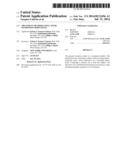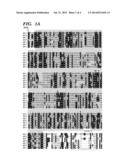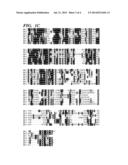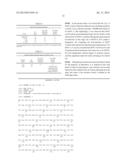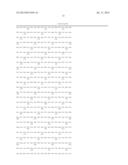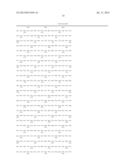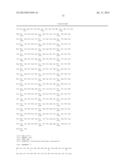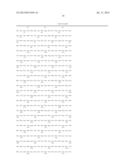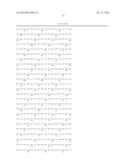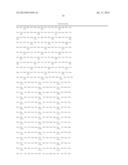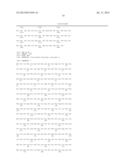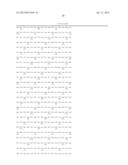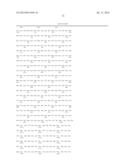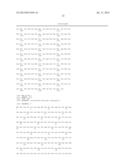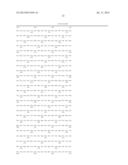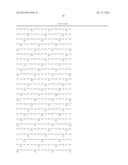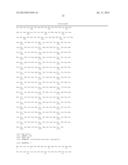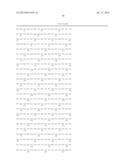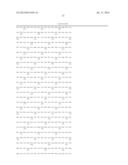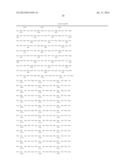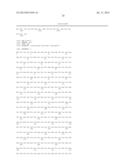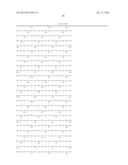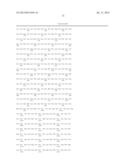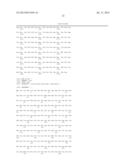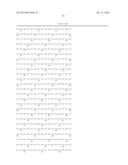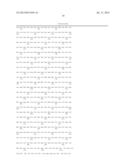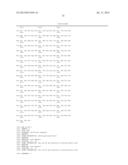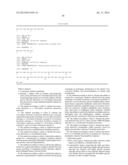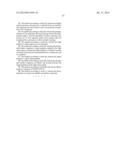Patent application title: TREATMENT METHODS USING ATOXIC NEUROTOXIN DERIVATIVES
Inventors:
Edwin J. Vazquez-Cintron (New York, NY, US)
Konstantin Ichtchenko (Brooklyn, NY, US)
Philip A. Band (West Orange, NJ, US)
Philip A. Band (West Orange, NJ, US)
Assignees:
New York University
IPC8 Class: AC12N952FI
USPC Class:
4242391
Class name: Bacterium or component thereof or substance produced by said bacterium (e.g., legionella, borrelia, anaplasma, shigella, etc.) toxin or toxoid, except endotoxin (e.g., exotoxin, enterotoxin, etc.) clostridium (e.g., clostridium tetani, etc.)
Publication date: 2014-07-31
Patent application number: 20140212456
Abstract:
The present invention relates to a treatment method. This method involves
contacting a subject with an isolated, physiologically active, atoxic
derivative of a Clostridial neurotoxin. Contacting is carried out to
treat the subject. The derivative of a Clostridial neurotoxin does not
possess a cargo attachment peptide sequence at its N-terminus.Claims:
1. A treatment method comprising: contacting a subject with an isolated,
physiologically active, atoxic derivative of a Clostridial neurotoxin,
said contacting being carried out to treat the subject, with the proviso
that the derivative of a Clostridial neurotoxin does not possess a cargo
attachment peptide sequence at its N-terminus.
2. The method according to claim 1, wherein the neurotoxin derivative is a Clostridium botulinum neurotoxin derivative.
3. The method according to claim 2, wherein the Clostridium botulinum neurotoxin derivative has a serotype selected from the group consisting of Clostridium botulinum serotype A, Clostridium botulinum serotype B, Clostridium botulinum serotype C, Clostridium botulinum serotype D, Clostridium botulinum serotype E, Clostridium botulinum serotype F, and Clostridium botulinum serotype G.
4. The method according to claim 1, wherein the neurotoxin derivative has a metalloprotease disabling mutation.
5. The method according to claim 1, wherein the neurotoxin derivative is a recombinant protein.
6. The method according to claim 1, wherein the subject is treated for a dermatologic or aesthetic condition selected from the group consisting of Rhtyiddess, hypertrophic masatteer muscles, and focal hyperhydrosis.
7. The method according to claim 1, wherein the subject is treated for a gastroenterological condition selected from the group consisting of esophageal motility disorders, pharyngeal-esophageal spasm, and anal fissure.
8. The method according to claim 1, wherein the subject is treated for a genitourinaric condition selected from the group consisting of neurogenic dysfunction of the urinary tract, overactive bladder, and neuromodulation of urinary urge incontinence.
9. The method according to claim 1, wherein the subject is treated for a neurologic condition selected from the group consisting of tourettes syndrome, focal muscle spasticity or dystonias, cervical dystonia, primary blepharospasm, hemifacial spasm, spasmodic dysphonia, facial nerve disorders, Rasmussen syndrome, amputation pain, voice tremor, crocodile tear syndrome, marginal mandibular nerve paralysis, pain, chest pain of esophageal origin, headache, cerebral palsy, hip adductor muscle dysfunction in multiple sclerosis, neurogenic pain and inflammation, arthritis, iatrogenic parotid sialocele, and chronic TMJ pain and displacement.
10. The method according to claim 1, wherein the neurotoxin derivative has an LD50 that is at least 1,000-fold higher than the LD50 of wild-type Clostridial neurotoxin.
11. The method according to claim 1, wherein the neurotoxin derivative accumulates within neuronal cytosol in higher amounts than wild-type Clostridial neurotoxin.
12. The method according to claim 1, wherein the derivative of a Clostridial neurotoxin is produced by cleaving a propeptide, wherein the propeptide comprises: a light chain region; a heavy chain region, wherein the light and heavy chain regions are linked by a disulfide bond; and an intermediate region connecting the light and heavy chain regions and comprising a highly specific protease cleavage site, wherein said highly specific protease cleavage site has three or more specific adjacent amino acid residues that are recognized by the highly specific protease in order to enable cleavage.
13. The method according to claim 12, wherein the highly specific protease cleavage site is selected from an enterokinase cleavage site and a tobacco etch virus protease recognition (TEV) sequence.
14. The method according to claim 12, wherein the propeptide has no low-specificity protease cleavage sites in the intermediate region, said low-specificity protease cleavage sites having two or less adjacent amino acid residues that are recognized by a protease in order to permit cleavage.
15. The method according to claim 12, wherein the light and heavy chain regions are not truncated.
16. The method according to claim 12, wherein the propeptide further comprises a signal peptide coupled to the light chain region, wherein the signal peptide is suitable to permit secretion of the neurotoxin propeptide from a eukaryotic cell to a medium.
17. The method according to claim 16, wherein the signal peptide is a gp64 signal peptide.
18. The method according to claim 16, wherein the propeptide further comprises an affinity tag located between the signal peptide and the light chain region.
19. The method according to claim 18, wherein the affinity tag has a sequence of SEQ ID NO:10.
20. The method according to claim 1, wherein the heavy chain has no trypsin-susceptible recognition sequences.
Description:
[0001] This application claims the benefit of U.S. Provisional Patent
Application Ser. No. 61/757,478, filed Jan. 28, 2013, which is hereby
incorporated by reference in its entirety.
FIELD OF THE INVENTION
[0003] This invention relates to treatment methods using atoxic neurotoxin derivatives.
BACKGROUND OF THE INVENTION
[0004] The Clostridial neurotoxins are a family of structurally similar proteins that target the neuronal machinery for synaptic vesicle exocytosis. Produced by anaerobic bacteria of the Clostridium genus, botulinum neurotoxins ("BoNT"s, seven immunologically distinct subtypes, A-G) and Tetanus neurotoxin ("TeNT") are the most poisonous substances known on a per-weight basis, with an LD50 in the range of 0.5-2.5 ng/kg when administered by intravenous or intramuscular routes (National Institute of Occupational Safety and Health, "Registry of Toxic Effects of Chemical Substances (R-TECS)," Cincinnati, Ohio: National Institute of Occupational Safety and Health (1996)). BoNTs target cholinergic nerves at their neuromuscular junction, inhibiting acetylcholine release and causing peripheral neuromuscular blockade (Simpson, "Identification of the Major Steps in Botulinum Toxin Action," Annu. Rev. Pharmacol. Toxicol. 44:167-193 (2004)).
[0005] A genetic engineering platform that enables rational design of therapeutic agents based on Clostridial toxin genes was described in U.S. Pat. No. 7,785,606 to Ichtchenko and Band. The genetic engineering scheme was based on a two-step approach. Gene constructs, expression systems, and purification schemes were designed that produce physiologically active, recombinant Clostridial neurotoxin derivatives. The recombinant toxin derivatives retained structural features important for developing therapeutic candidates, or useful biologic reagents. Using the genetic constructs and expression systems developed by this paradigm, selective point mutations were then introduced to create recombinant atoxic Clostridial neurotoxin derivatives.
[0006] Treatment methods that involve contacting a patient with isolated, physiologically active, toxic, Clostridial neurotoxin derivatives have been described in U.S. Pat. No. 7,785,606 to Band and Ichtchenko. Also, isolated, physiologically active, toxic and atoxic Clostridium botulinum neurotoxin derivatives that have an S6 peptide sequence fused to the N-terminus of the proteins to enable site-specific attachment of cargo using Sfp phosphopantetheinyl transferase have been described as suitable for treatment (U.S. Patent Application Publication No. 2011/0206616 to Ichtchenko and Band). However, methods that involve treatment with an atoxic derivative of a Clostridial neurotoxin lacking a cargo attachment sequence at its N-terminus, and having a much higher LD50 than a toxic derivative of a Clostridial neurotoxin or a wild type Clostridial neurotoxin, have not been described.
[0007] The present invention is directed to overcoming this and other limitations in the art.
SUMMARY OF THE INVENTION
[0008] The present invention relates to a treatment method. This method involves contacting a subject with an isolated, physiologically active, atoxic derivative of a Clostridial neurotoxin, said contacting being carried out to treat the subject, with the proviso that the neurotoxin derivative does not possess a cargo attachment peptide sequence at its N-terminus.
[0009] Genetic constructs and expression systems described herein are shown to produce a family of recombinant BoNT derivatives, with conformational and trafficking properties similar to the wild type BoNT toxins. These derivatives of Clostridial neurotoxins can be produced in toxic forms, having a toxicity comparable to that of the wild type toxin, or with mutations that reduce the metalloprotease activity responsible for toxicity (i.e., atoxic derivatives). The LD50 of the atoxic neurotoxin derivatives is much higher than that of the wild type toxin.
[0010] As described herein, the atoxic neurotoxin derivatives (see U.S. Pat. No. 7,785,606 to Ichtchenko et al., which is hereby incorporated by reference in its entirety) unexpectedly have in vivo activity similar to the wild type neurotoxins used for pharmaceutical purposes. Yet, atoxic neurotoxin derivatives described herein offer significant treatment benefits over current pharmaceutical preparations of wild type neurotoxins produced from cultures. In particular, the atoxic derivatives described herein are safer, providing distinct advantages for medical uses and production/manufacturing. The improved therapeutic index will enable application to conditions where the toxicity of wild type neurotoxins limit their use because of safety concerns.
BRIEF DESCRIPTION OF THE DRAWINGS
[0011] FIGS. 1A-C are a comparative alignment of amino acid sequences of seven wild type botulinum neurotoxin serotypes, including Clostridium botulinum serotype A (wt BoNT A) (SEQ ID NO:1), Clostridium botulinum serotype B (wt BoNT B) (SEQ ID NO:2), Clostridium botulinum serotype C (wt BoNT C) (SEQ ID NO:3), Clostridium botulinum serotype D (wt BoNT D) (SEQ ID NO:4), Clostridium botulinum serotype E (wt BoNT E) (SEQ ID NO:5), Clostridium botulinum serotype F (wt BoNT F) (SEQ ID NO:6), and Clostridium botulinum serotype G (wt BoNT G) (SEQ ID NO:7). Gaps have been introduced to maximize homology. Amino acids identical in ≧50% of compared sequences are shown in black boxes. Amino acids constituting the active site of the catalytic domain of metalloprotease are marked by stars. Disulfide bridge between neurotoxin cysteine residues of the light and heavy chain are shown as a long horizontal bracket. The amino acid residues constituting the minimal catalytic domain of the light chain are hatched. The first amino acid of the C-terminal part of the protein heavy chain (N872 for BoNT A), is shown with a white arrow, as is the first amino acid considered to constitute the receptor-binding domain. Amino acids absent in the mature dichain BoNT A molecule along with the aligned amino acids of the other BoNT serotypes are boxed. A white arrow is also positioned at the first amino acid of the neurotoxins' light chain.
[0012] FIG. 2 is a photograph showing the results of in vivo studies performed by intramuscular injection into the lateral gastrocnemius with 0.5 μg/mouse of BoNT A/ad-0 (experimental) in 3 μA of 0.9% NaCl or by injecting 3 μA of 0.9% of NaCl without BoNT A/ad-0 (control). Muscle paralysis and digital abduction was recorded 48 hours after. The two upper panel photographs show control mice, with the arrow in the upper right photograph indicating the site of injection. The three lower panel photographs show experimental mice. Digital abduction muscle paralysis was only observed in mice injected with BoNT A/ad-0. Experimental, n=10. Control, n=5. Representative results are shown in the photographs in the three bottom panels.
DETAILED DESCRIPTION OF THE INVENTION
[0013] The present invention relates to a treatment method. This method involves contacting a subject with an isolated, physiologically active, atoxic derivative of a Clostridial neurotoxin, said contacting being carried out to treat the subject, with the proviso that the neurotoxin derivative does not possess a cargo attachment peptide sequence at its N-terminus.
[0014] According to one embodiment, the derivative of a Clostridial neurotoxin of the present invention is a derivative of a Clostridium botulinum neurotoxin. Clostridium botulinum has multiple serotypes (A-G). Suitable derivatives of a Clostridial neurotoxin may be derivatives of any of the Clostridium botulinum serotypes. In addition, suitable derivatives of a Clostridial neurotoxin of the present invention may be derivatives of more than one Clostridium botulinum serotype. For example, it may be desirable to have a derivative of a Clostridial neurotoxin constructed of a light chain (LC) region from one Clostridium botulinum serotype (e.g., serotype A, BoNT A) and a heavy chain (HC) region from another Clostridium botulinum serotype (e.g., serotype B, BoNT B). Also, suitable derivatives of a Clostridial neurotoxin of the present invention include chimeras using other receptor ligands, e.g., epidermal growth factor ("EGF") for LC delivery to cancer cells (see U.S. Patent Application Publication no. 2012/0064059 to Foster et al., which is hereby incorporated by reference in its entirety).
[0015] By "derivative" it is meant that the Clostridial neurotoxin is substantially similar to the wild type toxin, but has been modified slightly as described herein. For example, derivatives include Clostridial neurotoxins that are at least 60%, 70%, 80%, 85%, 90%, 95%, 96%, 97%, 98%, or 99% identical to a wild type neurotoxin.
[0016] Isolated derivatives of a Clostridial neurotoxin are physiologically active. This physiological activity includes, but is not limited to, toxin immunogenicity, trans- and intra-cellular trafficking, cell recognition and targeting, and paralytic activity. In one embodiment, the derivative of a Clostridal neurotoxin is a derivative of a full-length Clostridial neurotoxin.
[0017] The atoxic derivative of a Clostridial neurotoxin designated herein using the "ad-0" designation, does not have an S6 peptide sequence fused to the N-terminus of the neurotoxin derivative, as described in U.S. Patent Application Publication No. 2011/0206616 to Icthtchenko and Band, which is hereby incorporated by reference in its entirety.
[0018] The mechanism of cellular binding and internalization of Clostridial neurotoxins is still not completely understood. The C-terminal portion of the heavy chain of all Clostridial neurotoxins binds to gangliosides (sialic acid-containing glycolipids), with a preference for gangliosides of the G1b series (Montecucco et al., "Structure and Function of Tetanus and Botulinum Neurotoxins," Q. Rev. Biophys. 28:423-472 (1995); Montecucco, "How Do Tetanus and Botulinum Toxins Bind to Neuronal Membranes?" TIBS 11:314-317 (1986); and Van Heyningen et al., "The Fixation of Tetanus Toxin by Ganglioside," J. Gen. Microbiol. 24:107-119 (1961), which are hereby incorporated by reference in their entirety). The sequence responsible for ganglioside binding has been identified for the structurally similar TeNT molecule, and is located within the 34 C-terminal amino acid residues of its heavy chain. BoNT A, BoNT B, BoNT C, BoNT E, and BoNT F share a high degree of homology with TeNT in this region (FIG. 1) (Shapiro et al., "Identification of a Ganglioside Recognition Domain of Tetanus Toxin Using a Novel Ganglioside Photoaffinity Ligand," J. Biol. Chem. 272:30380-30386 (1997), which is hereby incorporated by reference in its entirety). Multiple types of evidence suggest the existence of at least one additional component involved in the binding of Clostridial neurotoxins to neuronal membranes (Montecucco et al., "Structure and Function of Tetanus and Botulinum Neurotoxins," Q. Rev. Biophys. 28:423-472 (1995); Montecucco, "How Do Tetanus and Botulinum Toxins Bind to Neuronal Membranes?" TIBS 11:314-317 (1986), which are hereby incorporated by reference in their entirety). In two reports (Nishiki et al., "The High-Affinity Binding of Clostridium Botulinum Type B Neurotoxin to Synaptotagmin II Associated with Gangliosides G.sub.T1b/G.sub.D1a," FEBS Lett. 378:253-257 (1996); Dong et al., "Synaptotagmins I and II Mediate Entry of Botulinum Neurotoxin B into Cells," J. Cell Biol. 162:1293-1303 (2003), which are hereby incorporated by reference in their entirety), synaptotagmins were identified as possible candidates for the auxiliary BoNT B receptor, and synaptotagmins I and II were implicated as neuronal receptors for BoNT G (Rummel et al., "Synaptotagmins I and II Act as Nerve Cell Receptors for Botulinum Neurotoxin G," J. Biol. Chem. 279:30865-30870 (2004), which is hereby incorporated by reference in its entirety). Dong et al., "SV2 is the Protein Receptor for Botulinum Neurotoxin A," Science 312:592-596 (2006), which is hereby incorporated by reference in its entirety, showed that BoNT A enters neurons by binding to the synaptic vesicle protein SV2 (isoforms A, B, and C). However, despite the structural similarity in the putative receptor-binding domain of Clostridial neurotoxins, other toxin subtypes show no affinity for SV2 and instead may target synaptotagmins or synaptotagmin-related molecules. Lipid rafts (Herreros et al., "Lipid Rafts Act as Specialized Domains for Tetanus Toxin Binding and Internalization into Neurons," Mol. Biol. Cell 12:2947-2960 (2001), which is hereby incorporated by reference in its entirety) have been implicated as a specialized domain involved in TeNT binding and internalization into neurons, but these domains are widely distributed on multiple cell types, and therefore cannot simply explain the high specificity of the toxins for neurons.
[0019] Clostridial neurotoxins are internalized through the presynaptic membrane by an energy-dependent mechanism (Montecucco et al., "Structure and Function of Tetanus and Botulinum Neurotoxins," Q. Rev. Biophys. 28:423-472 (1995); Matteoli et al., "Synaptic Vesicle Endocytosis Mediates the Entry of Tetanus Neurotoxin into Hippocampal Neurons," Proc. Natl. Acad. Sci. USA 93:13310-13315 (1996); and Mukherjee et al., "Endocytosis," Physiol. Rev. 77:759-803 (1997), which are hereby incorporated by reference in their entirety), and rapidly appear in vesicles where they are at least partially protected from degradation (Dolly et al., "Acceptors for Botulinum Neurotoxin Reside on Motor Nerve Terminals and Mediate Its Internalization," Nature 307:457-460 (1984); Critchley et al., "Fate of Tetanus Toxin Bound to the Surface of Primary Neurons in Culture: Evidence for Rapid Internalization," J. Cell Biol. 100:1499-1507 (1985), which are hereby incorporated by reference in their entirety). The BoNT complex of light and heavy chains interacts with the endocytic vesicle membrane in a chaperone-like way, preventing aggregation and facilitating translocation of the light chain in a fashion similar to the protein conducting/translocating channels of smooth ER, mitochondria, and chloroplasts (Koriazova et al., "Translocation of Botulinum Neurotoxin Light Chain Protease through the Heavy Chain Channel," Nat. Struct. Biol. 10:13-18 (2003), which is hereby incorporated by reference in its entirety). Acidification of the endosome is believed to induce pore formation, which allows translocation of the light chain to the cytosol upon reduction of the interchain disulfide bond (Hoch et al., "Channels Formed by Botulinum, Tetanus, and Diphtheria Toxins in Planar Lipid Bilayers: Relevance to Translocation of Proteins Across Membranes," Proc. Natl. Acad. Sci. USA 82:1692-1696 (1985), which is hereby incorporated by reference in its entirety). Within the cytosol, the light chain displays a zinc-endopeptidase activity specific for protein components of the synaptic vesicle exocytosis apparatus. TeNT and BoNT B, BoNT D, BoNT F, and BoNT G recognize VAMP/synaptobrevin. This integral protein of the synaptic vesicle membrane is cleaved at a single peptide bond, which differs for each neurotoxin. BoNT A, BoNT C, and BoNT E recognize and cleave SNAP-25, a protein of the presynaptic membrane, at different sites within the carboxyl terminus segment. BoNT C also cleaves syntaxin, another protein of the nerve terminal plasmalemma (Montecucco et al., "Structure and Function of Tetanus and Botulinum Neurotoxins," Q. Rev. Biophys. 28:423-472 (1995); Sutton et al., "Crystal Structure of a SNARE Complex Involved in Synaptic Exocytosis at 2.4 A Resolution," Nature 395:347-353 (1998), which are hereby incorporated by reference in their entirety). The cleavage of such components of the synaptic release machinery results in inhibition of acetylcholine release in motor neurons, ultimately leading to neuromuscular paralysis.
[0020] The isolated derivative of a Clostridial neurotoxin employed in the method of the present invention is physiologically active and atoxic. The endopeptidase activity responsible for Clostridial neurotoxin toxicity is believed to be associated with the presence of a HExxHxxH (SEQ ID NO:8) motif in the light chain, characteristic of metalloproteases (FIGS. 1A-C). Mutagenesis of BoNT A light chain, followed by microinjection of the corresponding mRNA into presynaptic cholinergic neurons of Aplysia californica, allowed the minimal essential domain responsible for toxicity to be identified (Kurazono et al., "Minimal Essential Domains Specifying Toxicity of the Light Chains of Tetanus Toxin and Botulinum Neurotoxin Type A," J. Biol. Chem. 267:14721-14729 (1992), which is hereby incorporated by reference in its entirety). Site-directed mutagenesis of BoNT A light chain pinpointed the amino acid residues involved in Zn2+ coordination, and formation of the active metalloendoprotease core which cleaves SNAP-25 (Rigoni et al., "Site-Directed Mutagenesis Identifies Active-Site Residues of the Light Chain of Botulinum Neurotoxin Type A," Biochem. Biophys. Res. Commun. 288:1231-1237 (2001), which is hereby incorporated by reference in its entirety). The three-dimensional structures of Clostridial neurotoxins and their derivatives confirmed the mutagenesis results, and detailed the spatial organization of the protein domains. For the BoNT A holotoxin, crystal structure was obtained to a resolution of 3.3 {acute over (Å)} (Lacy et al., "Crystal Structure of Botulinum Neurotoxin Type A and Implications for Toxicity," Nat. Struct. Biol. 5:898-902 (1998), which is hereby incorporated by reference in its entirety). The BoNT B holotoxin crystal structure was determined at 1.8 and 2.6 {acute over (Å)} resolution (Swaminathan et al., "Structural Analysis of the Catalytic and Binding Sites of Clostridium Botulinum Neurotoxin B," Nat. Struct. Biol. 7:693-699 (2000), which is hereby incorporated by reference in its entirety). Recently, a crystal structure for BoNT E catalytic domain was determined to 2.1 {acute over (Å)} resolution (Agarwal et al., "Structural Analysis of Botulinum Neurotoxin Type E Catalytic Domain and Its Mutant Glu212>Gln Reveals the Pivotal Role of the Glu212 Carboxylate in the Catalytic Pathway," Biochemistry 43:6637-6644 (2004), which is hereby incorporated by reference in its entirety). The later study provided multiple interesting structural details, and helps explain the complete loss of metalloendoproteolytic activity in the BoNT E LC E212>Q mutant. The availability of this detailed information on the relationship between the amino acid sequence and biological activities of Clostridial toxins enables the design of modified toxin genes with properties specifically altered for therapeutic goals.
[0021] Thus, in one embodiment, the physiologically active and atoxic derivative of a Clostridial neurotoxin has a metalloprotease disabling mutation. Specific metalloprotease disabling mutations are described in U.S. Pat. No. 7,785,606 to Ichthchenko and Band, which is hereby incorporated by reference in its entirety. Additional point mutations can be introduced to further modify the characteristics of the atoxic derivative, some of which are also described in U.S. Pat. No. 7,785,606 to Ichthchenko and Band, which is hereby incorporated by reference in its entirety.
[0022] The physiologically active and atoxic derivative of a Clostridial neurotoxin may also have a non-native motif (e.g., a SNARE motif) in the light chain region that is capable of inactivating light chain metalloprotease activity in a toxic Clostridial neurotoxin, or otherwise modifying the behavior of the derivative. The sequences of nine non-native motifs that may be substituted for alpha-helix domains are described in U.S. Pat. No. 7,785,606 to Ichtchenko and Band, which is hereby incorporated by reference in its entirety. Atoxic derivatives that incorporate sequences to target other cellular receptors are also possible (e.g., EGF or cancer cells) (see U.S. Patent Application Publication No. 2012/0064059 to Foster et al., which is hereby incorporated by reference in its entirety).
[0023] In one embodiment, the physiologically active and atoxic derivative of a Clostridial neurotoxin has an LD50 that is at least 1,000; 2,000; 5,000; 7,000; 9,000; 10,000; 20,000; 30,000; 40,000; 50,000; 60,000; 70,000; 80,000; 90,000; 100,000; or 500,000-fold higher than the LD50 of wild type Clostridial neurotoxin. The particular mode of administration may affect the LD50 of the derivative of a Clostridial neurotoxin.
[0024] In one embodiment, the derivative of a Clostridal neurotoxin of the present invention is produced by cleaving a propeptide. The propeptide is cleaved at the highly specific protease cleavage site to form a light and heavy chain, with molecular weights of approximately 50 kD and 100 kD, respectively. The light and heavy chain regions are linked by a disulfide bond.
[0025] In one embodiment, the propeptide is contacted with a highly specific protease (e.g., enterokinase or TEV protease) under conditions effective to enable cleavage at the intermediate region of the propeptide of the present invention. Preferably, the expressed propeptide has one or more disulfide bridges.
[0026] As discussed infra, Clostridial neurotoxins and their derivatives described herein are synthesized as single chain propeptides which are later activated by a specific proteolysis cleavage event, generating a dimer joined by a disulfide bond. These structural features can be illustrated using BoNT A as an example, and are generally applicable to all Clostridium botulinum serotypes. The mature BoNT A is composed of three functional domains of Mr ˜50,000, where the catalytic function responsible for toxicity is confined to the light chain (residues 1-437), the translocation activity is associated with the N-terminal half of the heavy chain (residues 448-872), and cell binding is associated with its C-terminal half (residues 873-1,295) (Johnson, "Clostridial Toxins as Therapeutic Agents: Benefits of Nature's Most Toxic Proteins," Annu. Rev. Microbiol. 53:551-575 (1999); Montecucco et al., "Structure and Function of Tetanus and Botulinum Neurotoxins," Q. Rev. Biophys. 28:423-472 (1995), which are hereby incorporated by reference in their entirety).
[0027] Optimized expression and recovery of recombinant neurotoxins for BoNT serotypes in a native and physiologically active state is achieved by the introduction of one or more alterations to the nucleotide sequences encoding the BoNT propeptides, as discussed infra. These mutations are designed to maximize yield of recombinant derivatives of a Clostridial neurotoxin, while retaining the native toxins' structure and biological activity.
[0028] Common structural features of the wild-type Clostridium botulinum neurotoxin propeptides are shown in FIGS. 1A-C. These structural features are illustrated using wt BoNT A propeptide as an example, and are generalized among all Clostridium botulinum serotypes. wt BoNT A propeptide has two chains, a light chain ("LC") of Mr ˜50,000 and a heavy chain ("HC") of Mr ˜100,000, linked by a disulfide bond between Cys429 and Cys453. As illustrated in FIGS. 1A-C, all seven BoNT serotype propeptides have a light chain region and a heavy chain region linked by a disulfide bond. Two essential Cys residues, one adjacent to the C-terminus of the light chain, and a second adjacent to the N-terminus of the heavy chain are present in all seven BoNT serotypes. These two Cys residues form the single disulfide bond holding the HC and LC polypeptides together in the mature neurotoxin. This disulfide bond enables the mature neurotoxin to accomplish its native physiological activities by permitting the HC and LC to carry out their respective biological roles in concert. The disulfide bond between HC and LC polypeptides in all seven serotypes is illustrated in FIG. 1A by the solid line joining the involved Cys residues. The outlined box in FIG. 1A illustrates the intermediate region defined by amino acid residues Lys438-Lys448 of wt BoNT A. This intermediate region identifies the amino acids eliminated during maturation of wt BoNT A, and believed to be excised by a protease endogenous to the host microorganism. This cleavage event, described infra, generates the biologically active BoNT HC-LC dimer. The outlined amino acid residues in FIGS. 1A-C, representing amino acid residues approximately in the 420 to 450 range for all seven BoNT serotypes, can be considered as a region "non-essential" to the toxins' physiological activity and, therefore, represents targets for directed mutagenesis in all seven BoNT serotypes.
[0029] All seven wt BoNT serotypes referred to herein contain Lys or Arg residues in the intermediate region defined by the box in FIG. 1A, which make the propeptides susceptible to activation by trypsin. Native BoNT A propeptide recovered from young bacterial cultures can be activated by trypsinolysis, with production of intact, S--S bound light and heavy chain. Though multiple additional trypsin-susceptible sites are present in the propeptides, they are resistant to proteolysis due to their spatial positions within the native toxin molecule (Dekleva et al., "Nicking of Single Chain Clostridium botulinum Type A Neurotoxin by an Endogenous Protease," Biochem. Biophys. Res. Commun. 162:767-772 (1989); Lacy et al., "Crystal Structure of Botulinum Neurotoxin Type A and Implications for Toxicity," Nat. Struct. Biol. 5:898-902 (1998), which are hereby incorporated by reference in their entirety). A second site in the native propeptide of several BoNT serotypes can be susceptible to trypsin cleavage when subjected to higher enzyme concentrations or incubation times (Chaddock et al., "Expression and Purification of Catalytically Active, Non-Toxic Endopeptidase Derivatives of Clostridium botulinum Toxin Type A," Protein Expr. Purif. 25:219-228 (2002), which is hereby incorporated by reference in its entirety). This trypsin-susceptible site is located in the region adjacent to the toxin receptor binding domain. This region of the HC peptide is found to be exposed to solvent in BoNT serotypes for which information is available on their 3-D crystal structure (Lacy et al., "Crystal Structure of Botulinum Neurotoxin Type A and Implications for Toxicity," Nat. Struct. Biol. 5:898-902 (1998); Swaminathan et al., "Structural Analysis of the Catalytic and Binding Sites of Clostridium botulinum Neurotoxin B," Nat. Struct. Biol. 7:693-699 (2000), which are hereby incorporated by reference in their entirety).
[0030] In one embodiment, the propeptide has an intermediate region connecting the light and heavy chain regions which has a highly specific protease cleavage site and no low-specificity protease cleavage sites. For purposes of the present invention, a highly specific protease cleavage site has three or more specific adjacent amino acid residues that are recognized by the highly specific protease in order to permit cleavage (e.g., an enterokinase cleavage site or a TEV recognition sequence). In contrast, a low-specificity protease cleavage site has two or less adjacent amino acid residues that are recognized by a protease in order to enable cleavage (e.g., a trypsin cleavage site).
[0031] In all seven BoNT serotypes, the amino acid preceding the N-terminus of the heavy chain is a Lys or Arg residue which is susceptible to proteolysis with trypsin. This trypsin-susceptible site can be replaced with a five amino acid enterokinase cleavage site (i.e., DDDDK (SEQ ID NO:9)) upstream of the heavy chain's N-terminus. Alternatively, the trypsin-susceptible site can be replaced with a tobacco etch virus protease recognition ("TEV") sequence. Use of a TEV sequence enables a one-step heterodimer-forming cleavage event. See U.S. Patent Application Publication No. 2011/0206616 to Ichtchenko et al., which is hereby incorporated by reference in its entirety. Either of these modifications enables standardization activation with specific enzymes. In serotypes A and C, additional Lys residues within this region may be mutated to either Gln or His, thereby eliminating additional trypsin-susceptible sites. Trypsin-susceptible recognition sequences also occur upstream of the heavy chain's receptor-binding domain in serotypes A, E, and F. This region's susceptibility to proteolysis is consistent with its exposure to solvent in the toxin's 3-D structure, as shown by X-ray crystallography analysis. Therefore, in serotypes A, E, and F, the susceptible residues are modified to Asn. These modifications enable standardization activation with either enterokinase or TEV.
[0032] Signal peptides and N-terminal affinity tags are also preferably introduced, as required, to enable secretion and recovery and to eliminate truncated variants. The affinity tags can be separated from the N-terminus and C-terminus of the neurotoxin by cleavage using the same specific proteases used to cleave the heavy and light chain.
[0033] In one embodiment, the derivative of a Clostridial neurotoxin is from a propeptide that has a metalloprotease disabling mutation. The amino acid residues constituting the minimal catalytic domain of the light chain of the propeptide are illustrated in FIG. 1A by hatching. Specific amino acid residues constituting the active site of the catalytic domain of the metalloprotease are marked by stars in FIG. 1A.
[0034] A variety of Clostridial neurotoxin propeptides with light chain regions containing non-native motifs (e.g., SNARE motif peptides) in place of surface alpha-helix domains can be created. These non-native motif bearing propeptides are generated by altering the nucleotide sequences of nucleic acids encoding the propeptides.
[0035] In one embodiment, the light and heavy chains of the propeptide are not truncated.
[0036] In one embodiment, the propeptide further comprises a signal peptide coupled to the light chain region, where the signal peptide is suitable to permit secreation of the propeptide from a eukaryotic cell to a medium. Suitable signal peptides are described in U.S. Pat. No. 7,785,606 to Ichtchenko and Band, which is hereby incorporated by reference in its entirety. A suitable signal peptide is a gp64 signal peptide.
[0037] The propeptide may also have an affinity tag located between the signal peptide and the light chain region and/or at the C-terminus of the propeptide. A suitable affinity tag is the hexahistidine affinity tag MPMLSAIVLYVLLAAAAHSAFAAMVHHHHHHSAS . . . (SEQ ID NO:10). Structural variations of suitable Clostridial neurotoxin propeptides that possess a cargo attachment peptide sequence are described in U.S. Patent Application Publication No. 2011/0206616 to Ichtchenko and Band, which is hereby incorporated by reference in its entirety. Propeptides that encode atoxic derivatives of a Clostridial neurotoxin suitable for use in the method of the present invention may have any of the structural features of the propeptides described in U.S. Patent Application Publication No. 2011/0206616 to Ichtchenko and Band, which is hereby incorporated by reference in its entirety, other than the cargo attachment peptide sequence at the N-terminus. As described in U.S. Patent Application Publication No. 2011/0206616 to Ichtchenko and Band, which is hereby incorporated by reference in its entirety, a single protease cleavage step can be used for activation and removal of affinity tags.
[0038] Isolated nucleic acid molecules that encode atoxic derivatives of a Clostridial neurotoxin suitable for use in the method of the present invention are described in U.S. Pat. No. 7,785,606 to Ichtchenko and Band, which is hereby incorporated by reference in its entirety.
[0039] In one embodiment, the nucleic acid molecule has a metalloprotease disabling mutation, as described supra.
[0040] In one embodiment, the derivative of a Clostridal neurotoxin is a recombinant protein. Expression systems having a nucleic acid molecule encoding an isolated, physiologically active, atoxic derivative of a Clostridial neurotoxin in a heterologous vector, and host cells having a heterologous nucleic acid molecule encoding an isolated, physiologically active, atoxic derivative of a Clostridial neurotoxin are described in U.S. Pat. No. 7,785,606 to Ichtchenko and Band, which is hereby incorporated by reference in its entirety.
[0041] Expressing a recombinant, physiologically active, atoxic derivative of a Clostridial neurotoxin is carried out by providing a nucleic acid construct having a nucleic acid molecule encoding a propeptide as described herein. The nucleic acid construct has a heterologous promoter operably linked to the nucleic acid molecule and a 3' regulatory region operably linked to the nucleic acid molecule. The nucleic acid construct is then introduced into a host cell under conditions effective to express the physiologically active, atoxic derivative of a Clostridial neurotoxin.
[0042] In one embodiment, the expressed neurotoxin derivative is contacted with a highly specific protease under conditions effective to effect cleavage at the intermediate region. Preferably, the intermediate region of the propeptide is not cleaved by proteases endogenous to the expression system or the host cell.
[0043] Expression of a derivative of a Clostridial neurotoxin can be carried out by introducing a nucleic acid molecule encoding a propeptide into an expression system of choice using conventional recombinant technology. Generally, this involves inserting the nucleic acid molecule into an expression system to which the molecule is heterologous (i.e., not normally present). The introduction of a particular foreign or native gene into a mammalian host is facilitated by first introducing the gene sequence into a suitable nucleic acid vector. "Vector" is used herein to mean any genetic element, such as a plasmid, phage, transposon, cosmid, chromosome, virus, virion, etc., which is capable of replication when associated with the proper control elements and which is capable of transferring gene sequences between cells.
[0044] Thus, the term includes cloning and expression vectors, as well as viral vectors. The heterologous nucleic acid molecule is inserted into the expression system or vector in proper sense (5'→3') orientation and correct reading frame. The vector contains the necessary elements for the transcription and translation of the inserted Clostridial neurotoxin propeptide-coding sequences.
[0045] U.S. Pat. No. 4,237,224 to Cohen and Boyer, which is hereby incorporated by reference in its entirety, describes the production of expression systems in the form of recombinant plasmids using restriction enzyme cleavage and ligation with DNA ligase. These recombinant plasmids are then introduced by means of transformation and replicated in unicellular cultures including prokaryotic organisms and eukaryotic cells grown in culture.
[0046] Recombinant genes may also be introduced into viruses, including vaccinia virus, adenovirus, and retroviruses, including lentivirus. Recombinant viruses can be generated by transfection of plasmids into cells infected with virus.
[0047] Suitable vectors include, but are not limited to, the following viral vectors such as lambda vector system gt11, gt WES.tB, Charon 4, and plasmid vectors such as pBR322, pBR325, pACYC177, pACYC184, pUC8, pUC9, pUC18, pUC19, pLG339, pR290, pKC37, pKC101, SV 40, pBluescript II SK+/- or KS+/- (see "Stratagene Cloning Systems" Catalog (1993) from Stratagene, La Jolla, Calif., which is hereby incorporated by reference in its entirety), pQE, pIH821, pGEX, pFastBac series (Invitrogen), pET series (see F. W. Studier et. al., "Use of T7 RNA Polymerase to Direct Expression of Cloned Genes," Gene Expression Technology Vol. 185 (1990), which is hereby incorporated by reference in its entirety), and any derivatives thereof. Recombinant molecules can be introduced into cells via transformation, particularly transduction, conjugation, mobilization, or electroporation. The DNA sequences are cloned into the vector using standard cloning procedures in the art, as described by Sambrook et al., Molecular Cloning: A Laboratory Manual, Cold Springs Laboratory, Cold Springs Harbor, N.Y. (1989), which is hereby incorporated by reference in its entirety.
[0048] A variety of host-vector systems may be utilized to express the propeptide-encoding sequence in a cell. Primarily, the vector system must be compatible with the host cell used. Host-vector systems include but are not limited to the following: bacteria transformed with bacteriophage DNA, plasmid DNA, or cosmid DNA; microorganisms such as yeast containing yeast vectors; mammalian cell systems infected with virus (e.g., vaccinia virus, adenovirus, etc.); insect cell systems infected with virus (e.g., baculovirus); and plant cells infected by bacteria. The expression elements of these vectors vary in their strength and specificities. Depending upon the host-vector system utilized, any one of a number of suitable transcription and translation elements can be used.
[0049] Different genetic signals and processing events control many levels of gene expression (e.g., DNA transcription and messenger RNA ("mRNA") translation).
[0050] Transcription of DNA is dependent upon the presence of a promoter which is a DNA sequence that directs the binding of RNA polymerase and thereby promotes mRNA synthesis. The DNA sequences of eukaryotic promoters differ from those of prokaryotic promoters. Furthermore, eukaryotic promoters and accompanying genetic signals may not be recognized in or may not function in a prokaryotic system, and, further, prokaryotic promoters are not recognized and do not function in eukaryotic cells.
[0051] Similarly, translation of mRNA in prokaryotes depends upon the presence of the proper prokaryotic signals which differ from those of eukaryotes. Efficient translation of mRNA in prokaryotes requires a ribosome binding site called the Shine-Dalgarno ("SD") sequence on the mRNA. This sequence is a short nucleotide sequence of mRNA that is located before the start codon, usually AUG, which encodes the amino-terminal methionine of the protein. The SD sequences are complementary to the 3'-end of the 16S rRNA (ribosomal RNA) and probably promote binding of mRNA to ribosomes by duplexing with the rRNA to allow correct positioning of the ribosome. For a review on maximizing gene expression see Roberts and Lauer, Methods in Enzymology 68:473 (1979), which is hereby incorporated by reference in its entirety.
[0052] Promoters vary in their "strength" (i.e., their ability to promote transcription). For the purposes of expressing a cloned gene, it is desirable to use strong promoters in order to obtain a high level of transcription and, hence, expression of the gene. Depending upon the host cell system utilized, any one of a number of suitable promoters may be used. For instance, when cloning in E. coli, its bacteriophages, or plasmids, promoters such as the PH promoter, T7 phage promoter, lac promoter, trp promoter, recA promoter, ribosomal RNA promoter, the PR and PL promoters of coliphage lambda and others, including but not limited, to lacUV5, ompF, bla, lpp, and the like, may be used to direct high levels of transcription of adjacent DNA segments. Additionally, a hybrid trp-lacUV 5 (tac) promoter or other E. coli promoters produced by recombinant DNA or other synthetic DNA techniques may be used to provide for transcription of the inserted gene.
[0053] Bacterial host cell strains and expression vectors may be chosen which inhibit the action of the promoter unless specifically induced. In certain operons, the addition of specific inducers is necessary for efficient transcription of the inserted DNA. For example, the lac operon is induced by the addition of lactose or IPTG (isopropylthio-beta-D-galactoside). A variety of other operons, such as trp, pro, etc., are under different controls.
[0054] Specific initiation signals are also required for efficient gene transcription and translation in prokaryotic cells. These transcription and translation initiation signals may vary in "strength" as measured by the quantity of gene specific messenger RNA and protein synthesized, respectively. The DNA expression vector, which contains a promoter, may also contain any combination of various "strong" transcription and/or translation initiation signals. For instance, efficient translation in E. coli requires a Shine-Dalgarno ("SD") sequence about 7-9 bases 5' to the initiation codon (ATG) to provide a ribosome binding site. Thus, any SD-ATG combination that can be utilized by host cell ribosomes may be employed. Such combinations include but are not limited to the SD-ATG combination from the cro gene or the N gene of coliphage lambda, or from the E. coli tryptophan E, D, C, B or A genes. Additionally, any SD-ATG combination produced by recombinant DNA or other techniques involving incorporation of synthetic nucleotides may be used.
[0055] Depending on the vector system and host utilized, any number of suitable transcription and/or translation elements, including constitutive, inducible, and repressible promoters, as well as minimal 5' promoter elements may be used.
[0056] The nucleic acid, a promoter molecule of choice, a suitable 3' regulatory region, and if desired, a reporter gene, are incorporated into a vector-expression system of choice to prepare a nucleic acid construct using standard cloning procedures known in the art, such as described by Sambrook et al., Molecular Cloning: A Laboratory Manual, Third Edition, Cold Spring Harbor: Cold Spring Harbor Laboratory Press, New York (2001), which is hereby incorporated by reference in its entirety.
[0057] The nucleic acid molecule encoding a derivative of a Clostridial neurotoxin is inserted into a vector in the sense (i.e., 5'→3') direction, such that the open reading frame is properly oriented for the expression of the encoded propeptide under the control of a promoter of choice. Single or multiple nucleic acids may be ligated into an appropriate vector in this way, under the control of a suitable promoter, to prepare a nucleic acid construct.
[0058] Once the isolated nucleic acid molecule encoding the propeptide has been inserted into an expression vector, it is ready to be incorporated into a host cell. Recombinant molecules can be introduced into cells via transformation, particularly transduction, conjugation, lipofection, protoplast fusion, mobilization, particle bombardment, or electroporation. The DNA sequences are incorporated into the host cell using standard cloning procedures known in the art, as described by Sambrook et al., Molecular Cloning: A Laboratory Manual, Second Edition, Cold Springs Laboratory, Cold Springs Harbor, N.Y. (1989), which is hereby incorporated by reference in its entirety. Suitable hosts include, but are not limited to, bacteria, virus, yeast, fungi, mammalian cells, insect cells, plant cells, and the like. Preferable host cells of the present invention include, but are not limited to, Escherichia coli, insect cells, and Pichia pastoris cells.
[0059] Typically, an antibiotic or other compound useful for selective growth of the transformed cells only is added as a supplement to the media. The compound to be used will be dictated by the selectable marker element present in the plasmid with which the host cell was transformed. Suitable genes are those which confer resistance to gentamycin, G418, hygromycin, puromycin, streptomycin, spectinomycin, tetracycline, chloramphenicol, and the like. Similarly, "reporter genes" which encode enzymes providing for production of an identifiable compound, or other markers which indicate relevant information regarding the outcome of gene delivery, are suitable. For example, various luminescent or phosphorescent reporter genes are also appropriate, such that the presence of the heterologous gene may be ascertained visually.
[0060] In carrying out the method of the present invention, contacting a subject with the isolated, physiologically active, atoxic derivative of a Clostridal neurotoxin can be carried out by administering the isolated derivative of a Clostridial neurotoxin to a subject inhalationally, parenterally, for example, subcutaneously, intravenously, intramuscularly, intraperitoneally, by intranasal instillation, or by application to mucous membranes, such as, that of the nose, throat, and bronchial tubes. The neurotoxin derivative may be administered alone or with suitable pharmaceutical carriers, and can be in solid or liquid form such as, tablets, capsules, powders, solutions, suspensions, or emulsions.
[0061] The neurotoxin derivative may be orally administered, for example, with an inert diluent, or with an assimilable edible carrier, or may be enclosed in hard or soft shell capsules, or may be compressed into tablets, or may be incorporated directly with the food of the diet. For oral therapeutic administration, the neurotoxin derivative may be incorporated with excipients and used in the form of tablets, capsules, elixirs, suspensions, syrups, and the like. In one embodiment, the formulation includes hemagglutinin proteins similar to those produced by Clostridium species to protect the neurotoxin in the gastrointestinal tract. Such compositions and preparations should contain at least 0.1% of active compound. The percentage of the compound in these compositions may, of course, be varied and may conveniently be between about 2% to about 60% of the weight of the unit. The amount of active compound in such therapeutically useful compositions is such that a suitable dosage will be obtained.
[0062] The tablets, capsules, and the like may also contain a binder such as gum tragacanth, acacia, corn starch, or gelatin; excipients such as dicalcium phosphate; a disintegrating agent such as corn starch, potato starch, alginic acid; a lubricant such as magnesium stearate; and a sweetening agent such as sucrose, lactose, or saccharin. When the dosage unit form is a capsule, it may contain, in addition to materials of the above type, a liquid carrier, such as a fatty oil.
[0063] Various other materials may be present as coatings or to modify the physical form of the dosage unit. For instance, tablets may be coated with shellac, sugar, or both. A syrup may contain, in addition to active ingredient, sucrose as a sweetening agent, methyl and propylparabens as preservatives, a dye, and flavoring such as cherry or orange flavor.
[0064] The neurotoxin derivative may also be administered parenterally. Solutions or suspensions can be prepared in water suitably mixed with a surfactant, such as hydroxypropylcellulose. Dispersions can also be prepared in glycerol, liquid polyethylene glycols, and mixtures thereof in oils. Illustrative oils are those of petroleum, animal, vegetable, or synthetic origin, for example, peanut oil, soybean oil, or mineral oil. In general, water, saline, aqueous dextrose and related sugar solution, and glycols such as, propylene glycol or polyethylene glycol, are preferred liquid carriers, particularly for injectable solutions. Under ordinary conditions of storage and use, these preparations contain a preservative to prevent the growth of microorganisms.
[0065] The pharmaceutical forms suitable for injectable use include sterile aqueous solutions or dispersions and sterile powders for the extemporaneous preparation of sterile injectable solutions or dispersions. In all cases, the form must be sterile and must be fluid to the extent that syringability is possible. It must be stable under the conditions of manufacture and storage and can be preserved against the contaminating action of microorganisms, such as bacteria and fungi. The carrier can be a solvent or dispersion medium containing, for example, water, ethanol, polyol (e.g., glycerol, propylene glycol, and liquid polyethylene glycol), vegetable oils, hyaluronic acid, and suitable mixtures thereof.
[0066] The neurotoxin derivative may also be administered directly to the airways in the form of an aerosol. For use as aerosols, the neurotoxin derivative in solution or suspension may be packaged in a pressurized aerosol container together with suitable propellants, for example, hydrocarbon propellants like propane, butane, or isobutane with conventional adjuvants. The neurotoxin derivative also may be administered in a non-pressurized form such as in a nebulizer or atomizer.
[0067] BoNTs pass across epithelial surfaces without being destroyed or causing local toxicity. Passage across epithelia is believed to occur by specific binding and transcytosis. The ability of intact BoNT A to pass though pulmonary epithelia and resist proteolytic inactivation was demonstrated in rat primary alveolar epithelial cells and in immortalized human pulmonary adenocarcinoma (Calu-3) cells. The rate of transport was greater in the apical-to-basolateral direction than in the basolateral-to-apical direction, and it was blocked by serotype-specific toxin antibodies (Park et al., "Inhalational Poisoning by Botulinum Toxin and Inhalation Vaccination with Its Heavy-Chain Component," Infect. Immun. 71:1147-1154 (2003), which is hereby incorporated by reference in its entirety).
[0068] Targeting the CNS may require intra-thecal or intra-ventricular administration. Administration may occur directly to the CNS. Alternatively, administration to the CNS may involve retrograde transport from peripheral neurons (motor neurons, nociceptors) to spinal ganglia (see Caleo et al., "A Reappraisal of the Central Effects of Botulinum Neurotoxin Type A: By What Mechanism?" Journal of Neurochemistry 109:15-24 (2009), which is hereby incorporated by reference in its entirety).
[0069] Derivatives of a Clostridial neurotoxin of the present invention can be used to augment the endogenous pharmaceutical activity of wild type Clostridial neurotoxins (e.g., BOTOX®), e.g., as a combination therapy.
[0070] Derivatives of a Clostridial neurotoxin can be administered as a conjugate with a pharmaceutically acceptable water-soluble polymer moiety. By way of example, a polyethylene glycol conjugate is useful to increase the circulating half-life of the treatment compound, and to reduce the immunogenicity of the molecule. Specific PEG conjugates are described in U.S. Patent Application Publ. No. 2006/0074200 to Daugs et al., which is hereby incorporated by reference in its entirety. Other conjugates include HA, which are described in U.S. Pat. No. 7,879,341 to Taylor and U.S. Patent Application Publication No. 2012/0141532 to Blanda et al., each of which is hereby incorporated by reference in its entirety. Liquid forms, including liposome-encapsulated formulations, are illustrated by injectable solutions and suspensions. Exemplary solid forms include capsules, tablets, and controlled-release forms, such as a miniosmotic pump or an implant. Other dosage forms can be devised by those skilled in the art, as shown, for example, by Ansel and Popovich, Pharmaceutical Dosage Forms and Drug Delivery Systems, 5th Edition (Lea & Febiger 1990), Gennaro (ed.), Remington's Pharmaceutical Sciences, 19th Edition (Mack Publishing Company 1995), and by Ranade and Hollinger, Drug Delivery Systems (CRC Press 1996), each of which is hereby incorporated by reference in its entirety.
[0071] According to one embodiment, by treatment it is meant dermatologic or aesthetic treatment (see e.g., Carruthers et al., "Botulinum Toxin A in the Mid and Lower Face and Neck," Dermatol. Clin. 22:151-158 (2004); Lang, "History and Uses of BOTOX (Botulinum Toxin Type A)," Lippincotts Case Manag. 9:109-112 (2004); Naumann et al., "Safety of Botulinum Toxin Type A: A Systematic Review and Meta-Analysis," Curr. Med. Res. Opin. 20:981-990 (2004); Vartanian et al., "Facial Rejuvenation Using Botulinum Toxin A: Review and Updates," Facial Plast. Surg. 20:11-19 (2004), which are hereby incorporated by reference in their entirety) as well as therapeutic treatment (see e.g., Bentsianov et al., "Noncosmetic Uses of Botulinum Toxin," Clin. Dermatol. 22:82-88 (2004); Carruthers et al., "Botox: Beyond Wrinkles," Clin. Dermatol. 22:89-93 (2004); Jankovic, "Botulinum Toxin In Clinical Practice," J. Neurol. Neurosurg. Psychiatry 75:951-957 (2004); Klein, "The Therapeutic Potential of Botulinum Toxin," Dermatol. Surg. 30:452-455 (2004); Schurch, "The Role of Botulinum Toxin in Neurology," Drugs Today (Barc) 40:205-212 (2004), which are hereby incorporated by reference in their entirety).
[0072] Subjects to be treated pursuant to the method of the present invention include, without limitation, human and non-human primates, or other animals such as dog, cat, horse, cow, goat, sheep, rabbit, or rodent (e.g., mouse or rat).
[0073] Preferred treatment methods of the present invention include, but are not limited to, dermatologic or aesthetic treatment, gastroenterologic treatment, genitourinaric treatment, neurologic treatment, oncological treatment, and/or the treatment of any condition characterized by synaptopathology (see, e.g., Brose et al., "Synaptopathies: Dysfunction of Synaptic Function," Biochem. Soc. Trans. 38:443-444 (2010); Yu & Lu, "Synapses and Dendritic Spines as Pathogenic Targets in Alzheimer's Disease," Neural Plasticity 2012:1-8 (2012); Siskova et al., "Reactive Hypertrophy of Synaptic Varicosities Within the Hippocampus of Prion-Infected Mice," Biochem Soc. Trans. 38:471-475 (2010); Warner et al., "TorsinA and DYT1 Dystonia: A Synaptopathy?" Biochem. Soc. Trans. 38:452-456 (2010); Rozas et al., "Presynaptic Dysfunction in Huntington's Disease," Biochem Soc. Trans. 38:488-492 (2010); and Jones, "Errant Ensembles: Dysfunctional Neuronal Network Dynamics in Schizophrenia," Biochem. Soc. Trans. 38:516-521 (2010), which are hereby incorporated by reference in their entirety). Treatment of a condition characterized by synaptopathology may involve the neuromodulation of the synapse by the neurotoxin derivative.
[0074] Dermatologic or aesthetic treatment includes, but is not limited to, treatment for Rhtyiddess (wrinkles) (Sadick et al., "Comparison of Botulinum Toxins A and B in the Treatment of Facial Rhytides," Dermatol. Clin. 22:221-226 (2004), which is hereby incorporated by reference in its entirety), including glabellar (Carruthers et al., "Botulinum Toxin type A for the Treatment of Glabellar Rhytides," Dermatol. Clin. 22:137-144 (2004); Ozsoy et al., "Two-Plane Injection of Botulinum Exotoxin A in Glabellar Frown Lines," Aesthetic Plast. Surg. 28:114-115 (2004); which are hereby incorporated by reference in their entirety), neck lines (Brandt et al., "Botulinum Toxin for the Treatment of Neck Lines and Neck Bands," Dermatol. Clin. 22:159-166 (2004), which is hereby incorporated by reference in its entirety), crows feet (Levy et al., "Botulinum Toxin A: A 9-Month Clinical and 3D In Vivo Profilometric Crow's Feet Wrinkle Formation Study," J. Cosmet. Laser Ther. 6:16-20 (2004), which is hereby incorporated by reference in its entirety), and brow contour (Chen et al., "Altering Brow Contour with Botulinum Toxin," Facial Plast. Surg. Clin. North Am. 11:457-464 (2003), which is hereby incorporated by reference in its entirety). Other dermatologic treatment includes treatment for hypertrophic masateer muscles (Ahn et al., "Botulinum Toxin for Masseter Reduction in Asian Patients," Arch. Facial Plast. Surg. 6:188-191 (2004), which is hereby incorporated by reference in its entirety) and focal hyperhydrosis (Glogau, "Treatment of Hyperhidrosis with Botulinum Toxin," Dermatol. Clin. 22:177-185, vii (2004), which is hereby incorporated by reference in its entirety), including axillary ("Botulinum Toxin (Botox) for Axillary Hyperhidrosis," Med. Lett. Drugs Ther. 46:76 (2004), which is hereby incorporated by reference in its entirety) and genital (Lee et al., "A Case of Foul Genital Odor Treated with Botulinum Toxin A," Dermatol. Surg. 30:1233-1235 (2004), which is hereby incorporated by reference in its entirety).
[0075] Gastroentologic treatment includes, but is not limited to, treatment for esophageal motility disorders (Achem, "Treatment of Spastic Esophageal Motility Disorders," Gastroenterol. Clin. North Am. 33:107-124 (2004), which is hereby incorporated by reference in its entirety), pharyngeal-esophageal spasm (Bayles et al., "Operative Prevention and Management of Voice-Limiting Pharyngoesophageal Spasm," Otolaryngol. Clin. North Am. 37:547-558 (2004); Chao et al., "Management of Pharyngoesophageal Spasm with Botox," Otolaryngol. Clin. North Am. 37:559-566 (2004), which are hereby incorporated by reference in their entirety), and anal fissure (Brisinda et al., "Botulinum Neurotoxin to Treat Chronic Anal Fissure: Results of a Randomized `Botox vs. Dysport` Controlled Trial," Ailment Pharmacol. Ther. 19:695-701 (2004); Jost et al., "Botulinum Toxin A in Anal Fissure: Why Does it Work?" Dis. Colon Rectum 47:257-258 (2004), which are hereby incorporated by reference in their entirety).
[0076] Genitourinaric treatment includes, but is not limited to, treatment for neurogenic dysfunction of the urinary tract ("Botulinic Toxin in Patients with Neurogenic Dysfunction of the Lower Urinary Tracts," Urologia July-August: 44-48 (2004); Giannantoni et al., "Intravesical Resiniferatoxin Versus Botulinum-A Toxin Injections for Neurogenic Detrusor Overactivity: A Prospective Randomized Study," J. Urol. 172:240-243 (2004); Reitz et al., "Intravesical Therapy Options for Neurogenic Detrusor Overactivity," Spinal Cord 42:267-272 (2004), which are hereby incorporated by reference in their entirety), overactive bladder (Cruz, "Mechanisms Involved in New Therapies for Overactive Bladder," Urology 63:65-73 (2004), which is hereby incorporated by reference in its entirety), and neuromodulation of urinary urge incontinence (Abrams, "The Role of Neuromodulation in the Management of Urinary Urge Incontinence," BJU Int. 93:1116 (2004), which is hereby incorporated by reference in its entirety).
[0077] Neurologic treatment includes, but is not limited to, treatment for tourettes syndrome (Porta et al., "Treatment of Phonic Tics in Patients with Tourette's Syndrome Using Botulinum Toxin Type A," Neurol. Sci. 24:420-423 (2004), which is hereby incorporated by reference in its entirety) and focal muscle spasticity or dystonias (MacKinnon et al., "Corticospinal Excitability Accompanying Ballistic Wrist Movements in Primary Dystonia," Mov. Disord. 19:273-284 (2004), which is hereby incorporated by reference in its entirety), including, but not limited to, treatment for cervical dystonia (Haussermann et al., "Long-Term Follow-Up of Cervical Dystonia Patients Treated with Botulinum Toxin A," Mov. Disord. 19:303-308 (2004), which is hereby incorporated by reference in its entirety), primary blepharospasm (Defazio et al., "Primary Blepharospasm: Diagnosis and Management," Drugs 64:237-244 (2004), which is hereby incorporated by reference in its entirety), hemifacial spasm, post-stroke (Bakheit, "Optimising the Methods of Evaluation of the Effectiveness of Botulinum Toxin Treatment of Post-Stroke Muscle Spasticity," J. Neurol. Neurosurg. Psychiatry 75:665-666 (2004), which is hereby incorporated by reference in its entirety), spasmodic dysphonia (Bender et al., "Speech Intelligibility in Severe Adductor Spasmodic Dysphonia," J. Speech Lang. Hear Res. 47:21-32 (2004), which is hereby incorporated by reference in its entirety), facial nerve disorders (Finn, "Botulinum Toxin Type A: Fine-Tuning Treatment of Facial Nerve Injury," J. Drugs Dermatol. 3:133-137 (2004), which is hereby incorporated by reference in its entirety), and Rasmussen syndrome (Lozsadi et al., "Botulinum Toxin A Improves Involuntary Limb Movements in Rasmussen Syndrome," Neurology 62:1233-1234 (2004), which is hereby incorporated by reference in its entirety). Other neurologic treatments include treatment for amputation pain (Kern et al., "Effects of Botulinum Toxin Type B on Stump Pain and Involuntary Movements of the Stump," Am. J. Phys. Med. Rehabil. 83:396-399 (2004), which is hereby incorporated by reference in its entirety), voice tremor (Adler et al., "Botulinum Toxin Type A for Treating Voice Tremor," Arch. Neurol. 61:1416-1420 (2004), which is hereby incorporated by reference in its entirety), crocodile tear syndrome (Kyrmizakis et al., "The Use of Botulinum Toxin Type A in the Treatment of Frey and Crocodile Tears Syndrome," J. Oral Maxillofac. Surg. 62:840-844 (2004), which is hereby incorporated by reference in its entirety), marginal mandibular nerve paralysis, pain control, and anti-nociceptive effects (Cui et al., "Subcutaneous Administration of Botulinum Toxin A Reduces Formalin-Induced Pain," Pain 107:125-133 (2004) and U.S. Patent Application Publication No. 2012/0064059 to Foster et al., which are hereby incorporated by reference in its entirety), including but not limited to pain after mastectomy (Layeeque et al., "Botulinum Toxin Infiltration for Pain Control After Mastectomy and Expander Reconstruction," Ann. Surg. 240:608-613 (2004), which is hereby incorporated by reference in its entirety) and chest pain of esophageal origin (Schumulson et al., "Current and Future Treatment of Chest Pain of Presumed Esophageal Origin," Gastroenterol. Clin. North Am. 33:93-105 (2004), which is hereby incorporated by reference in its entirety). Another neurologic treatment amenable to the methods of the present invention is headache (Blumenfeld et al., "Botulinum Neurotoxin for the Treatment of Migraine and Other Primary Headache Disorders," Dermatol. Clin. 22:167-175 (2004), which is hereby incorporated by reference in its entirety).
[0078] The method of the present invention is also suitable for treatment of cerebral palsy (Balkrishnan et al., "Longitudinal Examination of Health Outcomes Associated with Botulinum Toxin Use in Children with Cerebral Palsy," J. Surg. Orthop. Adv. 13:76-80 (2004); Berweck et al., "Use of Botulinum Toxin in Pediatric Spasticity (Cerebral Palsy)," Mov. Disord. 19:S162-S167 (2004); Pidcock, "The Emerging Role of Therapeutic Botulinum Toxin in the Treatment of Cerebral Palsy," J. Pediatr. 145:S33-S35 (2004), which are hereby incorporated by reference in their entirety), hip adductor muscle dysfunction in multiple sclerosis (Wissel et al., "Botulinum Toxin Treatment of Hip Adductor Spasticity in Multiple Sclerosis," Wien Klin Wochesnchr 4:20-24 (2001), which is hereby incorporated by reference in its entirety), neurogenic pain and inflammation, including arthritis, iatrogenic parotid sialocele (Capaccio et al., "Diagnosis and Therapeutic Management of Iatrogenic Parotid Sialocele," Ann. Otol. Rhinol. Laryngol. 113:562-564 (2004), which is hereby incorporated by reference in its entirety), and chronic TMJ pain and displacement (Aquilina et al., "Reduction of a Chronic Bilateral Temporomandibular Joint Dislocation with Intermaxillary Fixation and Botulinum Toxin A," Br. J. Oral Maxillofac. Surg. 42:272-273 (2004), which is hereby incorporated by reference in its entirety). Other conditions that can be treated by local controlled delivery of pharmaceutically active neurotoxin derivatives include intra-articular administration for the treatment of arthritic conditions (Mahowald et al., "Long Term Effects of Intra-Articular BoNT A for Refractory Joint Pain," Annual Meeting of the American College of Rheumatology (2004), which is hereby incorporated by reference in its entirety), and local administration for the treatment of joint contracture (Russman et al., "Cerebral Palsy: A Rational Approach to a Treatment Protocol, and the Role of Botulinum Toxin in Treatment," Muscle Nerve Suppl. 6:S181-S193 (1997); Pucinelli et al., "Botulinic Toxin for the Rehabilitation of Osteoarthritis Fixed-Flexion Knee Deformity," Annual Meeting of the Osteoarthitis Research Society International (2004), which are hereby incorporated by reference in their entirety). The methods of the present invention are also suitable for the treatment of pain associated with various conditions characterized by the sensitization of nociceptors and their associated clinical syndromes, as described in Bach-Rojecky et al., "Antinociceptive Effect of Botulinum Toxin Type A In Rat Model of Carrageenan and Capsaicin Induced Pain," Croat. Med. J. 46:201-208 (2005); Aoki, "Evidence for Antinociceptive Activity of Botulinum Toxin Type A in Pain Management," Headache 43 Suppl 1:S9-15 (2003); Kramer et al., "Botulinum Toxin A Reduces Neurogenic Flare But Has Almost No Effect on Pain and Hyperalgesia in Human Skin," J. Neurol. 250:188-193 (2003); Blersch et al., "Botulinum Toxin A and the Cutaneous Nociception in Humans: A Prospective, Double-Blind, Placebo-Controlled, Randomized Study," J. Neurol. Sci. 205:59-63 (2002), which are hereby incorporated by reference in its entirety.
[0079] The neurotoxin derivatives may be customized to optimize therapeutic properties (See e.g., Chaddock et al., "Retargeted Clostridial Endopeptidases: Inhibition of Nociceptive Neurotransmitter Release In Vitro, and Antinociceptive Activity in In Vivo Models of Pain," Mov. Disord. 8:S42-S47 (2004); Finn, "Botulinum Toxin Type A: Fine-Tuning Treatment of Facial Nerve Injury," J. Drugs Dermatol. 3:133-137 (2004); Eleopra et al., "Different Types of Botulinum Toxin in Humans," Mov. Disord. 8:S53-S59 (2004); Flynn, "Myobloc," Dermatol. Clin. 22:207-211 (2004); and Sampaio et al., "Clinical Comparability of Marketed Formulations of Botulinum Toxin," Mov. Disord. 8:S129-S136 (2004), which are hereby incorporated by reference in their entirety).
[0080] The derivative of a Clostridial neurotoxin may also be used, pursuant to the treatment method of the present invention, to treat diseases influenced by activity-dependent changes in synaptic structure (e.g., synaptopathologies) or hyperactivity of synapse forming apparatus (e.g., tubulin polymerization), and conditions associated with the proliferation of microtubules. For example, Alzheimer's Disease, Parkinson's Disease, and neuronal cancers (of both neural and glial origin). Other conditions that may be treated by the method of the present invention include conditions where the synaptic complex is a disease target.
[0081] In one embodiment, neurotoxin derivatives of the present invention accumulate within neuronal cytosol in higher amounts than wild-type Clostridial neurotoxin.
EXAMPLES
Example 1
In-vivo Pharmaceutical Activity Experiments for BoNT A/ad-0
[0082] Material and Methods
[0083] An atoxic derivative of Clostridium botulinum serotype A ("BoNT A/ad"), as described in U.S. Pat. No. 7,785,606 to Ichtchenko and Band (which is hereby incorporated by reference in its entirety), was expressed as described. Since this neurotoxin derivative is atoxic and does not possess a cargo attachment peptide sequence at its N-terminus, it was designated "BoNT A/ad-0," where "ad-0" means atoxic derivative with no cargo site (0), as described herein. BoNT A/ad-0 was purified to electrophoretic homogeneity and activated by specific protease cleavage as described in Band et al., "Recombinant Derivatives of Botulinum Neurotoxin A Engingeered for Trafficking Studies and Neuronal Delivery," Protein Expression & Purification 71:62 (2010), which is hereby incorporated by reference in its entirety. The purified protein was prepared as a stock at a concentration of 10 mg/ml in PBS containing 40% glycerol for stabilization. The studies described below, evaluate the recombinant molecule's toxicity and pharmacologic activity.
[0084] Animals
[0085] Mice: female Balb/C mice, 5 to 7 weeks old; weight around 19+/-3 grams.
[0086] Digit Abduction Score (DAS) Assay
[0087] A modification of the classic mouse Digit Abduction Scoring ("DAS") assay was used to determine local pharmacologic activity in muscle, measured by muscle weakening effectiveness, as described in Aoki, "Preclinical Update on BOTOX® (Botulinum Toxin Type A)-Purified Neurotoxin Complex Relative to Other Botulinum Neurotoxin Preparations," European Journal of Neurology (1999), which is hereby incorporated by reference in its entirety. In the DAS Assay, mice are suspended by their tails briefly to elicit a characteristic startle response in which the animal extends its hind limbs and abducts its hind digits. The DAS assay is especially useful to compare the muscle weakening effectiveness of different BoNT preparations (Aoki, "Preclinical Update on BOTOX® (Botulinum Toxin Type A)-Purified Neurotoxin Complex Relative to Other Botulinum Neurotoxin Preparations," European Journal of Neurology (1999) and Aoki, "A Comparison of the Safety Margins of Botulinum Neurotoxin Serotypes A, B, and F In Mice," Toxicon 39:1815-1820 (2001), which are hereby incorporated by reference in their entirety).
[0088] This test was utilized to define pharmacological activity of BoNT A/ad-0 in mice. Mice were scored as having a positive DAS response when they were unable to fully extend all digits on the injected leg. A negative score is given to mice that spread the toes of the injected leg comparable to that of the non-injected leg.
[0089] Female Balb/C mice were given unilateral gastrocnemius intramuscular injections with the concentration described in a volume of 3 μl of 0.9% NaCl using a 25 μl Hamilton syringe. Muscle weakness was assessed from day 1 until 5 days post injection by suspending the mice in order to elicit a characteristic startle response and observing whether the toes on the injected leg were spreading compared to the non injected leg.
[0090] Measuring Paralysis
[0091] Definitive paralysis is described using two independent variables. First, the inability to use the injected leg to walk (paralysis); and second, the inability to spread the toes on the injected leg (digital abduction).
[0092] Results: Toxicity, LD50
[0093] The BoNT A/ad-0 preparation described above was used for the following toxicity study. The study was designed to approximate the standard murine LD50 test for wild type BoNT A ("wt BoNT A").
[0094] A total of 30 female mice were used in this study. Each mouse was injected intraperitoneally with the indicated dose of BoNT A/ad-0 in 200 μl of PBS (Table 1), and observed for 24 hours.
[0095] Doses ranging from 0.5 μg/mouse to 2 μg/mouse, based on the LD50 published by Pellett et al., "Neuronal Targeting, Internalization, and Biological Activity of a Recombinant Atoxic Derivative of Botulinum Neurotoxin A," Biochemical & Biophysical Research Communications 405(4):673-677 (2011), which is hereby incorporated by reference in its entirety), using BoNT A/ad (1.2 μg per mouse or 50 μg/kg body weight. The LD50 for BoNT A/ad-0 was found to be very similar to that for BoNT A/ad (Table 1). Briefly, 50% or 5 out of 10 mice injected with a dose of 50 μg/kg body weight showed symptoms of botulism intoxication by 36 hours. All mice injected with a dose of 2 μg, which is approximately 83.3 μg/kg body weight, expired within 48 hours. From this study it is concluded that 50 μg/kg body weight is the approximate LD50 of BoNT A/ad-0.
TABLE-US-00001 TABLE 1 Results of Toxicity (LD50) Study for BoNT A/ad-0 Injected Dose No. Mice Dead Survive 2 μg 10 10 0 1.2 μg 10 5 5 1 μg 5 1 4 0.5 μg 5 0 5
[0096] The LD50 of wt BoNT A is approximately 0.5 ng/kg (Aoki, "A Comparison of the Safety Margins of Botulinum Neurotoxin Serotypes A, B, and F In Mice," Toxicon 39:1815-1820 (2001), which is hereby incorporated by reference in its entirety), or 100,000-fold lower than that of BoNT A/ad-0. Because of this toxicity, the effectiveness of wt BoNT A at extremely low doses, and the variability in potency for BoNTs produced from a wild type bacterial source, pharmacological doses of wt BoNT A are generally specified in terms of "activity units," with 1 mouse LD50 of wt BoNT A considered to be 1 activity unit, or approximately 0.5 ng/kg of wt BoNT A (Aoki, "A Comparison of the Safety Margins of Botulinum Neurotoxin Serotypes A, B, and F In Mice," Toxicon 39:1815-1820 (2001), which is hereby incorporated by reference in its entirety). This takes into account concentration variations in the level of active toxin between preparations and manufacturers. Harmonized standards across producers remain undefined. This is due to both different manufacturing methods and batch-to-batch variation, but is also related to marketing claims. The final pharmaceutical preparations are formulated with albumin (BOTOX®) and/or lactose (Dysport®). From the LD50 results described here, it can be concluded that 1 LD50 Unit (1U) of BoNT A/ad-0 corresponds to a dose of approximately 50 μg/kg, or approximately 1.2 μg per mouse.
[0097] Results: Muscle Paralysis Study/DAS Assay for Pharmacologic Activity In Vivo
[0098] BoNT A/ad-0 described above was tested in the murine DAS to determine if BoNT A/ad-0 possesses pharmacological activity at doses significantly below its LD50, and whether it displays typical dose-response activity. Mice were injected in the gastrocnemius muscle with 3 μl of BoNT A/ad-0 in 0.9% NaCl using a 25 μl Hamilton Syringe. The doses administered are expressed as the μg administered per mouse, or units of BoNT A/ad-0 activity administered per mouse (Table 2).
[0099] Two observations are noted to categorize a mouse as positive for muscle paralysis induced by administration of BoNT A/ad-0. First, by the inability of the mouse to use the injected leg to walk (muscle paralysis). Second, by observing whether the digits on the injected leg appeared collapsed (digital abduction). Definite muscle paralysis was initially observed and recorded 24 hours after the initial administration. Mice were daily evaluated for definitive muscle paralysis for a maximum of 5 days.
[0100] The results of this pharmacologic study of BoNT A/ad-0 are shown in Table 2 and FIG. 2. Mice administered doses ranging from 0.008 LD50 units (0.01 μg) to 0.42 LD50 units (0.5 μg) of BoNT A/ad-0 showed definitive muscle paralysis and digital abduction (FIG. 2 and Table 2), without any signs of mortality. In fact, 4 out of 5 animals injected with 0.01 μg presented with muscle paralysis and some degree of digital abduction (Table 2), indicating that the ED50 for BoNT A/ad-0, the lowest dose at which 50% of the injected animals demonstrate the intended pharmacologic activity, is 0.01 μg or lower, which corresponds to 0.008 LD50 units or lower. All mice that presented paralysis on day 1 continued to present paralysis to the end of the study, day 5. No signs of systemic toxicity were observed in any of the mice in this study.
[0101] These data confirm that BoNT A/ad-0 has similar pharmaceutical properties compared to wt BoNT A, albeit with a dose-response profile, a significantly increased range of safe therapeutic activity and, therefore, an improved therapeutic index, and an improved safety margin. This comparison of BoNT A/ad-0 to pharmaceutical preparations of wt BoNT is illustrated in Table 3, and contrasted to the data reported by Aoki, "A Comparison of the Safety Margins of Botulinum Neurotoxin Serotypes A, B, and F In Mice," Toxicon 39:1815-1820 (2001), which is hereby incorporated by reference in its entirety. For instance, Aoki, "A Comparison of the Safety Margins of Botulinum Neurotoxin Serotypes A, B, and F In Mice," Toxicon 39:1815-1820 (2001), which is hereby incorporated by reference in its entirety, reported that the safety margin for BOTOX® is about 13.9+/-1.7 and for Dysport® 7.6+/-0.9. Here it is shown that at the lowest dose of BoNT A/ad-0 studied, 0.01 μg, definite paralysisis was observed in 4/5 mice. This dose can be considered a conservative estimate of the ED50. Therefore, for BoNT A/ad-0, the safety margin is approximately 120, or expressed differently, approximately 10-fold better that that for BOTOX® or Dysport® (Table 3).
TABLE-US-00002 TABLE 2 Results of Pharmacologic Study of BoNT A/ad-0 Dose No. with Injected LD50 No. Definitive No. per Mouse Units Mice Paralysis Dead 0 (placebo) 0 9 0 0 0.01 μg 0.008 5 4 0 0.1 μg 0.08 5 5 0 0.5 μg 0.42 10 10 0 1 μg 0.83 5 5 0 1.2 μg 1 5 2 3 1.5 μg 1.25 5 1 4 Naive mice were administered BoNT A/ad-0 in the left gastrocnemius via intramuscular injection with 3 μl containing the indicated mass or units of BoNT A/ad-0.
TABLE-US-00003 TABLE 3 LD50 and ED50 of BoNT A/ad-0 LD50 = ~1.2 μg ED50 = ~0.01 ug (ED50 = 0.01 μg or lower) LD50/ED50 = safety margin = ~120
[0102] If expressed as units, the ED50 of BoNT A/ad-0 is 0.008 LD50 units, or lower.
[0103] Comparison to Prior Studies and Conclusions
[0104] Prior studies have found that mutations introduced into the light chain of recombinant BoNT A/ad (a molecule containing a cargo attachment peptide as described in U.S. Patent Application Publication No. 2011/0206616 to Ichtchenko and Band, which is hereby incorporated by reference in its entirety) increased the LD50 of the toxin by 100,000-fold. In particular, injections of 0.5 μg (n=25) or 1 μg (n=15) of BoNT A/ad (in the absence of any therapeutic agent) were made into the tibialis muscle two months prior to administration of the repeat dose to each animal. The repeat dose, consisting of 3 μl containing the indicated quantitites of BoNT A/ad, 1 μg (n=18) or 2 μg (n=20), were similarly injected into the tibialis muscle. These data (Table 4 and Table 5) suggest that immune resistance to BoNT A/ad is not developing with repeat treatment.
TABLE-US-00004 TABLE 4 BoNT A/ad Induces Paralysis No. with No. Dead No. Definitive (within Dose Mice Paralysis 48 hrs) 0 (placebo) 21 0 0 0.5 μg 38 34 0 1 μg 15 12 1 1.2 μg 10 5 5 1.2 μg is the apparent LD50 for intramuscular injections of BoNT A/ad estimated from this experiment.
TABLE-US-00005 TABLE 5 Paralytic Effect After Re-injection of BoNT A/ad No. with No. Dead Repeat No. Definitive (within Dose Mice Paralysis 48 hrs) 1 μg 18 17 0 2 μg 20 15 dead, with 3 appearing sick. 2 mice appeared normal at 48 hrs.
[0105] In the present study it was found that the LD50 of BoNT A/ad-0, which has identical toxin-disabling mutations as BoNT A/ad, is likewise elevated ˜100,000-fold relative to wt BoNT A. But surprisingly, it was observed that BoNT A/ad-0 still possessed pharmacologic activity similar to that observed for wt BoNT A, and that a therapeutic agent need not be delivered via the cargo site of BoNT/A ad to render it therapeutic. By comparing the dose-response of BoNT A/ad-0 to that reported for pharmaceutical preparations of wt BoNT A, it can be concluded that BoNT A/ad-0 can be used for pharmaceutical treatments in the same way as wt BoNTs, but with significantly reduced danger of systemic toxicity, and thus significant improved safety advantages for clinical use.
[0106] Although the invention has been described in detail for the purposes of illustration, it is understood that such detail is solely for that purpose, and variations can be made therein by those skilled in the art without departing from the spirit and scope of the invention which is defined by the following claims.
Sequence CWU
1
1
1011296PRTClostridium botulinum (serotype A) 1Met Pro Phe Val Asn Lys Gln
Phe Asn Tyr Lys Asp Pro Val Asn Gly 1 5
10 15 Val Asp Ile Ala Tyr Ile Lys Ile Pro Asn Ala
Gly Gln Met Gln Pro 20 25
30 Val Lys Ala Phe Lys Ile His Asn Lys Ile Trp Val Ile Pro Glu
Arg 35 40 45 Asp
Thr Phe Thr Asn Pro Glu Glu Gly Asp Leu Asn Pro Pro Pro Glu 50
55 60 Ala Lys Gln Val Pro Val
Ser Tyr Tyr Asp Ser Thr Tyr Leu Ser Thr 65 70
75 80 Asp Asn Glu Lys Asp Asn Tyr Leu Lys Gly Val
Thr Lys Leu Phe Glu 85 90
95 Arg Ile Tyr Ser Thr Asp Leu Gly Arg Met Leu Leu Thr Ser Ile Val
100 105 110 Arg Gly
Ile Pro Phe Trp Gly Gly Ser Thr Ile Asp Thr Glu Leu Lys 115
120 125 Val Ile Asp Thr Asn Cys Ile
Asn Val Ile Gln Pro Asp Gly Ser Tyr 130 135
140 Arg Ser Glu Glu Leu Asn Leu Val Ile Ile Gly Pro
Ser Ala Asp Ile 145 150 155
160 Ile Gln Phe Glu Cys Lys Ser Phe Gly His Glu Val Leu Asn Leu Thr
165 170 175 Arg Asn Gly
Tyr Gly Ser Thr Gln Tyr Ile Arg Phe Ser Pro Asp Phe 180
185 190 Thr Phe Gly Phe Glu Glu Ser Leu
Glu Val Asp Thr Asn Pro Leu Leu 195 200
205 Gly Ala Gly Lys Phe Ala Thr Asp Pro Ala Val Thr Leu
Ala His Glu 210 215 220
Leu Ile His Ala Gly His Arg Leu Tyr Gly Ile Ala Ile Asn Pro Asn 225
230 235 240 Arg Val Phe Lys
Val Asn Thr Asn Ala Tyr Tyr Glu Met Ser Gly Leu 245
250 255 Glu Val Ser Phe Glu Glu Leu Arg Thr
Phe Gly Gly His Asp Ala Lys 260 265
270 Phe Ile Asp Ser Leu Gln Glu Asn Glu Phe Arg Leu Tyr Tyr
Tyr Asn 275 280 285
Lys Phe Lys Asp Ile Ala Ser Thr Leu Asn Lys Ala Lys Ser Ile Val 290
295 300 Gly Thr Thr Ala Ser
Leu Gln Tyr Met Lys Asn Val Phe Lys Glu Lys 305 310
315 320 Tyr Leu Leu Ser Glu Asp Thr Ser Gly Lys
Phe Ser Val Asp Lys Leu 325 330
335 Lys Phe Asp Lys Leu Tyr Lys Met Leu Thr Glu Ile Thr Thr Glu
Asp 340 345 350 Asn
Phe Val Lys Phe Phe Lys Val Leu Asn Arg Lys Thr Tyr Leu Asn 355
360 365 Phe Asp Lys Ala Val Phe
Lys Ile Asn Ile Val Pro Lys Val Asn Tyr 370 375
380 Thr Ile Tyr Asp Gly Phe Asn Leu Arg Asn Thr
Asn Leu Ala Ala Asn 385 390 395
400 Phe Asn Gly Gln Asn Thr Glu Ile Asn Asn Met Asn Phe Thr Lys Leu
405 410 415 Lys Asn
Phe Thr Gly Leu Phe Glu Phe Tyr Lys Leu Leu Cys Val Arg 420
425 430 Gly Ile Ile Thr Ser Lys Thr
Lys Ser Leu Asp Lys Gly Tyr Asn Lys 435 440
445 Ala Leu Asn Asp Leu Cys Ile Lys Val Asn Asn Trp
Asp Leu Phe Phe 450 455 460
Ser Pro Ser Glu Asp Asn Phe Thr Asn Asp Leu Asn Lys Gly Glu Glu 465
470 475 480 Ile Thr Ser
Asp Thr Asn Ile Glu Ala Ala Glu Glu Asn Ile Ser Leu 485
490 495 Asp Leu Ile Gln Gln Tyr Tyr Leu
Thr Phe Asn Phe Asp Asn Glu Pro 500 505
510 Glu Asn Ile Ser Ile Glu Asn Leu Ser Ser Asp Ile Ile
Gly Gln Leu 515 520 525
Glu Leu Met Pro Asn Ile Glu Arg Phe Pro Asn Gly Lys Lys Tyr Glu 530
535 540 Leu Asp Lys Tyr
Thr Met Phe His Tyr Leu Arg Ala Gln Glu Phe Glu 545 550
555 560 His Gly Lys Ser Arg Ile Ala Leu Thr
Asn Ser Val Asn Glu Ala Leu 565 570
575 Leu Asn Pro Ser Arg Val Tyr Thr Phe Phe Ser Ser Asp Tyr
Val Lys 580 585 590
Lys Val Asn Lys Ala Thr Glu Ala Ala Met Phe Leu Gly Trp Val Glu
595 600 605 Gln Leu Val Tyr
Asp Phe Thr Asp Glu Thr Ser Glu Val Ser Thr Thr 610
615 620 Asp Lys Ile Ala Asp Ile Thr Ile
Ile Ile Pro Tyr Ile Gly Pro Ala 625 630
635 640 Leu Asn Ile Gly Asn Met Leu Tyr Lys Asp Asp Phe
Val Gly Ala Leu 645 650
655 Ile Phe Ser Gly Ala Val Ile Leu Leu Glu Phe Ile Pro Glu Ile Ala
660 665 670 Ile Pro Val
Leu Gly Thr Phe Ala Leu Val Ser Tyr Ile Ala Asn Lys 675
680 685 Val Leu Thr Val Gln Thr Ile Asp
Asn Ala Leu Ser Lys Arg Asn Glu 690 695
700 Lys Trp Asp Glu Val Tyr Lys Tyr Ile Val Thr Asn Trp
Leu Ala Lys 705 710 715
720 Val Asn Thr Gln Ile Asp Leu Ile Arg Lys Lys Met Lys Glu Ala Leu
725 730 735 Glu Asn Gln Ala
Glu Ala Thr Lys Ala Ile Ile Asn Tyr Gln Tyr Asn 740
745 750 Gln Tyr Thr Glu Glu Glu Lys Asn Asn
Ile Asn Phe Asn Ile Asp Asp 755 760
765 Leu Ser Ser Lys Leu Asn Glu Ser Ile Asn Lys Ala Met Ile
Asn Ile 770 775 780
Asn Lys Phe Leu Asn Gln Cys Ser Val Ser Tyr Leu Met Asn Ser Met 785
790 795 800 Ile Pro Tyr Gly Val
Lys Arg Leu Glu Asp Phe Asp Ala Ser Leu Lys 805
810 815 Asp Ala Leu Leu Lys Tyr Ile Tyr Asp Asn
Arg Gly Thr Leu Ile Gly 820 825
830 Gln Val Asp Arg Leu Lys Asp Lys Val Asn Asn Thr Leu Ser Thr
Asp 835 840 845 Ile
Pro Phe Gln Leu Ser Lys Tyr Val Asp Asn Gln Arg Leu Leu Ser 850
855 860 Thr Phe Thr Glu Tyr Ile
Lys Asn Ile Ile Asn Thr Ser Ile Leu Asn 865 870
875 880 Leu Arg Tyr Glu Ser Asn His Leu Ile Asp Leu
Ser Arg Tyr Ala Ser 885 890
895 Lys Ile Asn Ile Gly Ser Lys Val Asn Phe Asp Pro Ile Asp Lys Asn
900 905 910 Gln Ile
Gln Leu Phe Asn Leu Glu Ser Ser Lys Ile Glu Val Ile Leu 915
920 925 Lys Asn Ala Ile Val Tyr Asn
Ser Met Tyr Glu Asn Phe Ser Thr Ser 930 935
940 Phe Trp Ile Arg Ile Pro Lys Tyr Phe Asn Ser Ile
Ser Leu Asn Asn 945 950 955
960 Glu Tyr Thr Ile Ile Asn Cys Met Glu Asn Asn Ser Gly Trp Lys Val
965 970 975 Ser Leu Asn
Tyr Gly Glu Ile Ile Trp Thr Leu Gln Asp Thr Gln Glu 980
985 990 Ile Lys Gln Arg Val Val Phe Lys
Tyr Ser Gln Met Ile Asn Ile Ser 995 1000
1005 Asp Tyr Ile Asn Arg Trp Ile Phe Val Thr Ile
Thr Asn Asn Arg 1010 1015 1020
Leu Asn Asn Ser Lys Ile Tyr Ile Asn Gly Arg Leu Ile Asp Gln
1025 1030 1035 Lys Pro Ile
Ser Asn Leu Gly Asn Ile His Ala Ser Asn Asn Ile 1040
1045 1050 Met Phe Lys Leu Asp Gly Cys Arg
Asp Thr His Arg Tyr Ile Trp 1055 1060
1065 Ile Lys Tyr Phe Asn Leu Phe Asp Lys Glu Leu Asn Glu
Lys Glu 1070 1075 1080
Ile Lys Asp Leu Tyr Asp Asn Gln Ser Asn Ser Gly Ile Leu Lys 1085
1090 1095 Asp Phe Trp Gly Asp
Tyr Leu Gln Tyr Asp Lys Pro Tyr Tyr Met 1100 1105
1110 Leu Asn Leu Tyr Asp Pro Asn Lys Tyr Val
Asp Val Asn Asn Val 1115 1120 1125
Gly Ile Arg Gly Tyr Met Tyr Leu Lys Gly Pro Arg Gly Ser Val
1130 1135 1140 Met Thr
Thr Asn Ile Tyr Leu Asn Ser Ser Leu Tyr Arg Gly Thr 1145
1150 1155 Lys Phe Ile Ile Lys Lys Tyr
Ala Ser Gly Asn Lys Asp Asn Ile 1160 1165
1170 Val Arg Asn Asn Asp Arg Val Tyr Ile Asn Val Val
Val Lys Asn 1175 1180 1185
Lys Glu Tyr Arg Leu Ala Thr Asn Ala Ser Gln Ala Gly Val Glu 1190
1195 1200 Lys Ile Leu Ser Ala
Leu Glu Ile Pro Asp Val Gly Asn Leu Ser 1205 1210
1215 Gln Val Val Val Met Lys Ser Lys Asn Asp
Gln Gly Ile Thr Asn 1220 1225 1230
Lys Cys Lys Met Asn Leu Gln Asp Asn Asn Gly Asn Asp Ile Gly
1235 1240 1245 Phe Ile
Gly Phe His Gln Phe Asn Asn Ile Ala Lys Leu Val Ala 1250
1255 1260 Ser Asn Trp Tyr Asn Arg Gln
Ile Glu Arg Ser Ser Arg Thr Leu 1265 1270
1275 Gly Cys Ser Trp Glu Phe Ile Pro Val Asp Asp Gly
Trp Gly Glu 1280 1285 1290
Arg Pro Leu 1295 21291PRTClostridium botulinum (serotype B)
2Met Pro Val Thr Ile Asn Asn Phe Asn Tyr Asn Asp Pro Ile Asp Asn 1
5 10 15 Asn Asn Ile Ile
Met Met Glu Pro Pro Phe Ala Arg Gly Thr Gly Arg 20
25 30 Tyr Tyr Lys Ala Phe Lys Ile Thr Asp
Arg Ile Trp Ile Ile Pro Glu 35 40
45 Arg Tyr Thr Phe Gly Tyr Lys Pro Glu Asp Phe Asn Lys Ser
Ser Gly 50 55 60
Ile Phe Asn Arg Asp Val Cys Glu Tyr Tyr Asp Pro Asp Tyr Leu Asn 65
70 75 80 Thr Asn Asp Lys Lys
Asn Ile Phe Leu Gln Thr Met Ile Lys Leu Phe 85
90 95 Asn Arg Ile Lys Ser Lys Pro Leu Gly Glu
Lys Leu Leu Glu Met Ile 100 105
110 Ile Asn Gly Ile Pro Tyr Leu Gly Asp Arg Arg Val Pro Leu Glu
Glu 115 120 125 Phe
Asn Thr Asn Ile Ala Ser Val Thr Val Asn Lys Leu Ile Ser Asn 130
135 140 Pro Gly Glu Val Glu Arg
Lys Lys Gly Ile Phe Ala Asn Leu Ile Ile 145 150
155 160 Phe Gly Pro Gly Pro Val Leu Asn Glu Asn Glu
Thr Ile Asp Ile Gly 165 170
175 Ile Gln Asn His Phe Ala Ser Arg Glu Gly Phe Gly Gly Ile Met Gln
180 185 190 Met Lys
Phe Cys Pro Glu Tyr Val Ser Val Phe Asn Asn Val Gln Glu 195
200 205 Asn Lys Gly Ala Ser Ile Phe
Asn Arg Arg Gly Tyr Phe Ser Asp Pro 210 215
220 Ala Leu Ile Leu Met His Glu Leu Ile His Val Leu
His Gly Leu Tyr 225 230 235
240 Gly Ile Lys Val Asp Asp Leu Pro Ile Val Pro Asn Glu Lys Lys Phe
245 250 255 Phe Met Gln
Ser Thr Asp Ala Ile Gln Ala Glu Glu Leu Tyr Thr Phe 260
265 270 Gly Gly Gln Asp Pro Ser Ile Ile
Thr Pro Ser Thr Asp Lys Ser Ile 275 280
285 Tyr Asp Lys Val Leu Gln Asn Phe Arg Gly Ile Val Asp
Arg Leu Asn 290 295 300
Lys Val Leu Val Cys Ile Ser Asp Pro Asn Ile Asn Ile Asn Ile Tyr 305
310 315 320 Lys Asn Lys Phe
Lys Asp Lys Tyr Lys Phe Val Glu Asp Ser Glu Gly 325
330 335 Lys Tyr Ser Ile Asp Val Glu Ser Phe
Asp Lys Leu Tyr Lys Ser Leu 340 345
350 Met Phe Gly Phe Thr Glu Thr Asn Ile Ala Glu Asn Tyr Lys
Ile Lys 355 360 365
Thr Arg Ala Ser Tyr Phe Ser Asp Ser Leu Pro Pro Val Lys Ile Lys 370
375 380 Asn Leu Leu Asp Asn
Glu Ile Tyr Thr Ile Glu Glu Gly Phe Asn Ile 385 390
395 400 Ser Asp Lys Asp Met Glu Lys Glu Tyr Arg
Gly Gln Asn Lys Ala Ile 405 410
415 Asn Lys Gln Ala Tyr Glu Glu Ile Ser Lys Glu His Leu Ala Val
Tyr 420 425 430 Lys
Ile Gln Met Cys Lys Ser Val Lys Ala Pro Gly Ile Cys Ile Asp 435
440 445 Val Asp Asn Glu Asp Leu
Phe Phe Ile Ala Asp Lys Asn Ser Phe Ser 450 455
460 Asp Asp Leu Ser Lys Asn Glu Arg Ile Glu Tyr
Asn Thr Gln Ser Asn 465 470 475
480 Tyr Ile Glu Asn Asp Phe Pro Ile Asn Glu Leu Ile Leu Asp Thr Asp
485 490 495 Leu Ile
Ser Lys Ile Glu Leu Pro Ser Glu Asn Thr Glu Ser Leu Thr 500
505 510 Asp Phe Asn Val Asp Val Pro
Val Tyr Glu Lys Gln Pro Ala Ile Lys 515 520
525 Lys Ile Phe Thr Asp Glu Asn Thr Ile Phe Gln Tyr
Leu Tyr Ser Gln 530 535 540
Thr Phe Pro Leu Asp Ile Arg Asp Ile Ser Leu Thr Ser Ser Phe Asp 545
550 555 560 Asp Ala Leu
Leu Phe Ser Asn Lys Val Tyr Ser Phe Phe Ser Met Asp 565
570 575 Tyr Ile Lys Thr Ala Asn Lys Val
Val Glu Ala Gly Leu Phe Ala Gly 580 585
590 Trp Val Lys Gln Ile Val Asn Asp Phe Val Ile Glu Ala
Asn Lys Ser 595 600 605
Asn Thr Met Asp Lys Ile Ala Asp Ile Ser Leu Ile Val Pro Tyr Ile 610
615 620 Gly Leu Ala Leu
Asn Val Gly Asn Glu Thr Ala Lys Gly Asn Phe Glu 625 630
635 640 Asn Ala Phe Glu Ile Ala Gly Ala Ser
Ile Leu Leu Glu Phe Ile Pro 645 650
655 Glu Leu Leu Ile Pro Val Val Gly Ala Phe Leu Leu Glu Ser
Tyr Ile 660 665 670
Asp Asn Lys Asn Lys Ile Ile Lys Thr Ile Asp Asn Ala Leu Thr Lys
675 680 685 Arg Asn Glu Lys
Trp Ser Asp Met Tyr Gly Leu Ile Val Ala Gln Trp 690
695 700 Leu Ser Thr Val Asn Thr Gln Phe
Tyr Thr Ile Lys Glu Gly Met Tyr 705 710
715 720 Lys Ala Leu Asn Tyr Gln Ala Gln Ala Leu Lys Glu
Ile Ile Lys Tyr 725 730
735 Arg Tyr Asn Ile Tyr Ser Glu Lys Glu Lys Ser Asn Ile Asn Ile Asp
740 745 750 Phe Asn Asp
Ile Asn Ser Lys Leu Asn Glu Gly Ile Asn Gln Ala Ile 755
760 765 Asp Asn Ile Asn Asn Phe Ile Asn
Gly Cys Ser Val Ser Tyr Leu Met 770 775
780 Lys Lys Met Ile Pro Leu Ala Val Glu Lys Leu Leu Asp
Phe Asp Asn 785 790 795
800 Thr Leu Lys Lys Asn Leu Leu Asn Tyr Ile Asp Glu Asn Lys Leu Tyr
805 810 815 Leu Ile Gly Ser
Ala Glu Tyr Glu Lys Ser Lys Val Asn Lys Tyr Leu 820
825 830 Lys Thr Ile Met Pro Phe Asp Leu Ser
Ile Tyr Thr Asn Asp Thr Ile 835 840
845 Leu Ile Glu Met Phe Asn Lys Tyr Asn Ser Glu Ile Leu Asn
Asn Ile 850 855 860
Ile Leu Asn Leu Arg Tyr Lys Asp Asn Asn Leu Ile Asp Leu Ser Gly 865
870 875 880 Tyr Gly Ala Lys Val
Glu Val Tyr Asp Gly Val Glu Leu Asn Asp Lys 885
890 895 Asn Gln Phe Lys Leu Thr Ser Ser Ala Asn
Ser Lys Ile Arg Val Thr 900 905
910 Gln Asn Gln Asn Ile Ile Phe Asn Ser Val Phe Leu Asp Phe Ser
Val 915 920 925 Ser
Phe Trp Ile Arg Ile Pro Lys Tyr Lys Asn Asp Gly Ile Gln Asn 930
935 940 Tyr Ile His Asn Glu Tyr
Thr Ile Ile Asn Cys Met Lys Asn Asn Ser 945 950
955 960 Gly Trp Lys Ile Ser Ile Arg Gly Asn Arg Ile
Ile Trp Thr Leu Ile 965 970
975 Asp Ile Asn Gly Lys Thr Lys Ser Val Phe Phe Glu Tyr Asn Ile Arg
980 985 990 Glu Asp
Ile Ser Glu Tyr Ile Asn Arg Trp Phe Phe Val Thr Ile Thr 995
1000 1005 Asn Asn Leu Asn Asn
Ala Lys Ile Tyr Ile Asn Gly Lys Leu Glu 1010 1015
1020 Ser Asn Thr Asp Ile Lys Asp Ile Arg Glu
Val Ile Ala Asn Gly 1025 1030 1035
Glu Ile Ile Phe Lys Leu Asp Gly Asp Ile Asp Arg Thr Gln Phe
1040 1045 1050 Ile Trp
Met Lys Tyr Phe Ser Ile Phe Asn Thr Glu Leu Ser Gln 1055
1060 1065 Ser Asn Ile Glu Glu Arg Tyr
Lys Ile Gln Ser Tyr Ser Glu Tyr 1070 1075
1080 Leu Lys Asp Phe Trp Gly Asn Pro Leu Met Tyr Asn
Lys Glu Tyr 1085 1090 1095
Tyr Met Phe Asn Ala Gly Asn Lys Asn Ser Tyr Ile Lys Leu Lys 1100
1105 1110 Lys Asp Ser Pro Val
Gly Glu Ile Leu Thr Arg Ser Lys Tyr Asn 1115 1120
1125 Gln Asn Ser Lys Tyr Ile Asn Tyr Arg Asp
Leu Tyr Ile Gly Glu 1130 1135 1140
Lys Phe Ile Ile Arg Arg Lys Ser Asn Ser Gln Ser Ile Asn Asp
1145 1150 1155 Asp Ile
Val Arg Lys Glu Asp Tyr Ile Tyr Leu Asp Phe Phe Asn 1160
1165 1170 Leu Asn Gln Glu Trp Arg Val
Tyr Thr Tyr Lys Tyr Phe Lys Lys 1175 1180
1185 Glu Glu Glu Lys Leu Phe Leu Ala Pro Ile Ser Asp
Ser Asp Glu 1190 1195 1200
Phe Tyr Asn Thr Ile Gln Ile Lys Glu Tyr Asp Glu Gln Pro Thr 1205
1210 1215 Tyr Ser Cys Gln Leu
Leu Phe Lys Lys Asp Glu Glu Ser Thr Asp 1220 1225
1230 Glu Ile Gly Leu Ile Gly Ile His Arg Phe
Tyr Glu Ser Gly Ile 1235 1240 1245
Val Phe Glu Glu Tyr Lys Asp Tyr Phe Cys Ile Ser Lys Trp Tyr
1250 1255 1260 Leu Lys
Glu Val Lys Arg Lys Pro Tyr Asn Leu Lys Leu Gly Cys 1265
1270 1275 Asn Trp Gln Phe Ile Pro Lys
Asp Glu Gly Trp Thr Glu 1280 1285
1290 31291PRTClostridium botulinum (serotype C) 3Met Pro Ile Thr Ile
Asn Asn Phe Asn Tyr Ser Asp Pro Val Asp Asn 1 5
10 15 Lys Asn Ile Leu Tyr Leu Asp Thr His Leu
Asn Thr Leu Ala Asn Glu 20 25
30 Pro Glu Lys Ala Phe Arg Ile Thr Gly Asn Ile Trp Val Ile Pro
Asp 35 40 45 Arg
Phe Ser Arg Asn Ser Asn Pro Asn Leu Asn Lys Pro Pro Arg Val 50
55 60 Thr Ser Pro Lys Ser Gly
Tyr Tyr Asp Pro Asn Tyr Leu Ser Thr Asp 65 70
75 80 Ser Asp Lys Asp Pro Phe Leu Lys Glu Ile Ile
Lys Leu Phe Lys Arg 85 90
95 Ile Asn Ser Arg Glu Ile Gly Glu Glu Leu Ile Tyr Arg Leu Ser Thr
100 105 110 Asp Ile
Pro Phe Pro Gly Asn Asn Asn Thr Pro Ile Asn Thr Phe Asp 115
120 125 Phe Asp Val Asp Phe Asn Ser
Val Asp Val Lys Thr Arg Gln Gly Asn 130 135
140 Asn Trp Val Lys Thr Gly Ser Ile Asn Pro Ser Val
Ile Ile Thr Gly 145 150 155
160 Pro Arg Glu Asn Ile Ile Asp Pro Glu Thr Ser Thr Phe Lys Leu Thr
165 170 175 Asn Asn Thr
Phe Ala Ala Gln Glu Gly Phe Gly Ala Leu Ser Ile Ile 180
185 190 Ser Ile Ser Pro Arg Phe Met Leu
Thr Tyr Ser Asn Ala Thr Asn Asp 195 200
205 Val Gly Glu Gly Arg Phe Ser Lys Ser Glu Phe Cys Met
Asp Pro Ile 210 215 220
Leu Ile Leu Met His Glu Leu Asn His Ala Met His Asn Leu Tyr Gly 225
230 235 240 Ile Ala Ile Pro
Asn Asp Gln Thr Ile Ser Ser Val Thr Ser Asn Ile 245
250 255 Phe Tyr Ser Gln Tyr Asn Val Lys Leu
Glu Tyr Ala Glu Ile Tyr Ala 260 265
270 Phe Gly Gly Pro Thr Ile Asp Leu Ile Pro Lys Ser Ala Arg
Lys Tyr 275 280 285
Phe Glu Glu Lys Ala Leu Asp Tyr Tyr Arg Ser Ile Ala Lys Arg Leu 290
295 300 Asn Ser Ile Thr Thr
Ala Asn Pro Ser Ser Phe Asn Lys Tyr Ile Gly 305 310
315 320 Glu Tyr Lys Gln Lys Leu Ile Arg Lys Tyr
Arg Phe Val Val Glu Ser 325 330
335 Ser Gly Glu Val Thr Val Asn Arg Asn Lys Phe Val Glu Leu Tyr
Asn 340 345 350 Glu
Leu Thr Gln Ile Phe Thr Glu Phe Asn Tyr Ala Lys Ile Tyr Asn 355
360 365 Val Gln Asn Arg Lys Ile
Tyr Leu Ser Asn Val Tyr Thr Pro Val Thr 370 375
380 Ala Asn Ile Leu Asp Asp Asn Val Tyr Asp Ile
Gln Asn Gly Phe Asn 385 390 395
400 Ile Pro Lys Ser Asn Leu Asn Val Leu Phe Met Gly Gln Asn Leu Ser
405 410 415 Arg Asn
Pro Ala Leu Arg Lys Val Asn Pro Glu Asn Met Leu Tyr Leu 420
425 430 Phe Thr Lys Phe Cys His Lys
Ala Ile Asp Gly Arg Ser Leu Tyr Asn 435 440
445 Lys Thr Leu Asp Cys Arg Glu Leu Leu Val Lys Asn
Thr Asp Leu Pro 450 455 460
Phe Ile Gly Asp Ile Ser Asp Val Lys Thr Asp Ile Phe Leu Arg Lys 465
470 475 480 Asp Ile Asn
Glu Glu Thr Glu Val Ile Tyr Tyr Pro Asp Asn Val Ser 485
490 495 Val Asp Gln Val Ile Leu Ser Lys
Asn Thr Ser Glu His Gly Gln Leu 500 505
510 Asp Leu Leu Tyr Pro Ser Ile Asp Ser Glu Ser Glu Ile
Leu Pro Gly 515 520 525
Glu Asn Gln Val Phe Tyr Asp Asn Arg Thr Gln Asn Val Asp Tyr Leu 530
535 540 Asn Ser Tyr Tyr
Tyr Leu Glu Ser Gln Lys Leu Ser Asp Asn Val Glu 545 550
555 560 Asp Phe Thr Phe Thr Arg Ser Ile Glu
Glu Ala Leu Asp Asn Ser Ala 565 570
575 Lys Val Tyr Thr Tyr Phe Pro Thr Leu Ala Asn Lys Val Asn
Ala Gly 580 585 590
Val Gln Gly Gly Leu Phe Leu Met Trp Ala Asn Asp Val Val Glu Asp
595 600 605 Phe Thr Thr Asn
Ile Leu Arg Lys Asp Thr Leu Asp Lys Ile Ser Asp 610
615 620 Val Ser Ala Ile Ile Pro Tyr Ile
Gly Pro Ala Leu Asn Ile Ser Asn 625 630
635 640 Ser Val Arg Arg Gly Asn Phe Thr Glu Ala Phe Ala
Val Thr Gly Val 645 650
655 Thr Ile Leu Leu Glu Ala Phe Pro Glu Phe Thr Ile Pro Ala Leu Gly
660 665 670 Ala Phe Val
Ile Tyr Ser Lys Val Gln Glu Arg Asn Glu Ile Ile Lys 675
680 685 Thr Ile Asp Asn Cys Leu Glu Gln
Arg Ile Lys Arg Trp Lys Asp Ser 690 695
700 Tyr Glu Trp Met Met Gly Thr Trp Leu Ser Arg Ile Ile
Thr Gln Phe 705 710 715
720 Asn Asn Ile Ser Tyr Gln Met Tyr Asp Ser Leu Asn Tyr Gln Ala Gly
725 730 735 Ala Ile Lys Ala
Lys Ile Asp Leu Glu Tyr Lys Lys Tyr Ser Gly Ser 740
745 750 Asp Lys Glu Asn Ile Lys Ser Gln Val
Glu Asn Leu Lys Asn Ser Leu 755 760
765 Asp Val Lys Ile Ser Glu Ala Met Asn Asn Ile Asn Lys Phe
Ile Arg 770 775 780
Glu Cys Ser Val Thr Tyr Leu Phe Lys Asn Met Leu Pro Lys Val Ile 785
790 795 800 Asp Glu Leu Asn Glu
Phe Asp Arg Asn Thr Lys Ala Lys Leu Ile Asn 805
810 815 Leu Ile Asp Ser His Asn Ile Ile Leu Val
Gly Glu Val Asp Lys Leu 820 825
830 Lys Ala Lys Val Asn Asn Ser Phe Gln Asn Thr Ile Pro Phe Asn
Ile 835 840 845 Phe
Ser Tyr Thr Asn Asn Ser Leu Leu Lys Asp Ile Ile Asn Glu Tyr 850
855 860 Phe Asn Asn Ile Asn Asp
Ser Lys Ile Leu Ser Leu Gln Asn Arg Lys 865 870
875 880 Asn Thr Leu Val Asp Thr Ser Gly Tyr Asn Ala
Glu Val Ser Glu Glu 885 890
895 Gly Asp Val Gln Leu Asn Pro Ile Phe Pro Phe Asp Phe Lys Leu Gly
900 905 910 Ser Ser
Gly Glu Asp Arg Gly Lys Val Ile Val Thr Gln Asn Glu Asn 915
920 925 Ile Val Tyr Asn Ser Met Tyr
Glu Ser Phe Ser Ile Ser Phe Trp Ile 930 935
940 Arg Ile Asn Lys Trp Val Ser Asn Leu Pro Gly Tyr
Thr Ile Ile Asp 945 950 955
960 Ser Val Lys Asn Asn Ser Gly Trp Ser Ile Gly Ile Ile Ser Asn Phe
965 970 975 Leu Val Phe
Thr Leu Lys Gln Asn Glu Asp Ser Glu Gln Ser Ile Asn 980
985 990 Phe Ser Tyr Asp Ile Ser Asn Asn
Ala Pro Gly Tyr Asn Lys Trp Phe 995 1000
1005 Phe Val Thr Val Thr Asn Asn Met Met Gly Asn
Met Lys Ile Tyr 1010 1015 1020
Ile Asn Gly Lys Leu Ile Asp Thr Ile Lys Val Lys Glu Leu Thr
1025 1030 1035 Gly Ile Asn
Phe Ser Lys Thr Ile Thr Phe Glu Ile Asn Lys Ile 1040
1045 1050 Pro Asp Thr Gly Leu Ile Thr Ser
Asp Ser Asp Asn Ile Asn Met 1055 1060
1065 Trp Ile Arg Asp Phe Tyr Ile Phe Ala Lys Glu Leu Asp
Gly Lys 1070 1075 1080
Asp Ile Asn Ile Leu Phe Asn Ser Leu Gln Tyr Thr Asn Val Val 1085
1090 1095 Lys Asp Tyr Trp Gly
Asn Asp Leu Arg Tyr Asn Lys Glu Tyr Tyr 1100 1105
1110 Met Val Asn Ile Asp Tyr Leu Asn Arg Tyr
Met Tyr Ala Asn Ser 1115 1120 1125
Arg Gln Ile Val Phe Asn Thr Arg Arg Asn Asn Asn Asp Phe Asn
1130 1135 1140 Glu Gly
Tyr Lys Ile Ile Ile Lys Arg Ile Arg Gly Asn Thr Asn 1145
1150 1155 Asp Thr Arg Val Arg Gly Gly
Asp Ile Leu Tyr Phe Asp Met Thr 1160 1165
1170 Ile Asn Asn Lys Ala Tyr Asn Leu Phe Met Lys Asn
Glu Thr Met 1175 1180 1185
Tyr Ala Asp Asn His Ser Thr Glu Asp Ile Tyr Ala Ile Gly Leu 1190
1195 1200 Arg Glu Gln Thr Lys
Asp Ile Asn Asp Asn Ile Ile Phe Gln Ile 1205 1210
1215 Gln Pro Met Asn Asn Thr Tyr Tyr Tyr Ala
Ser Gln Ile Phe Lys 1220 1225 1230
Ser Asn Phe Asn Gly Glu Asn Ile Ser Gly Ile Cys Ser Ile Gly
1235 1240 1245 Thr Tyr
Arg Phe Arg Leu Gly Gly Asp Trp Tyr Arg His Asn Tyr 1250
1255 1260 Leu Val Pro Thr Val Lys Gln
Gly Asn Tyr Ala Ser Leu Leu Glu 1265 1270
1275 Ser Thr Ser Thr His Trp Gly Phe Val Pro Val Ser
Glu 1280 1285 1290
41276PRTClostridium botulinum (serotype D) 4Met Thr Trp Pro Val Lys Asp
Phe Asn Tyr Ser Asp Pro Val Asn Asp 1 5
10 15 Asn Asp Ile Leu Tyr Leu Arg Ile Pro Gln Asn
Lys Leu Ile Thr Thr 20 25
30 Pro Val Lys Ala Phe Met Ile Thr Gln Asn Ile Trp Val Ile Pro
Glu 35 40 45 Arg
Phe Ser Ser Asp Thr Asn Pro Ser Leu Ser Lys Pro Pro Arg Pro 50
55 60 Thr Ser Lys Tyr Gln Ser
Tyr Tyr Asp Pro Ser Tyr Leu Ser Thr Asp 65 70
75 80 Glu Gln Lys Asp Thr Phe Leu Lys Gly Ile Ile
Lys Leu Phe Lys Arg 85 90
95 Ile Asn Glu Arg Asp Ile Gly Lys Lys Leu Ile Asn Tyr Leu Val Val
100 105 110 Gly Ser
Pro Phe Met Gly Asp Ser Ser Thr Pro Glu Asp Thr Phe Asp 115
120 125 Phe Thr Arg His Thr Thr Asn
Ile Ala Val Glu Lys Phe Glu Asn Gly 130 135
140 Ser Trp Lys Val Thr Asn Ile Ile Thr Pro Ser Val
Leu Ile Phe Gly 145 150 155
160 Pro Leu Pro Asn Ile Leu Asp Tyr Thr Ala Ser Leu Thr Leu Gln Gly
165 170 175 Gln Gln Ser
Asn Pro Ser Phe Glu Gly Phe Gly Thr Leu Ser Ile Leu 180
185 190 Lys Val Ala Pro Glu Phe Leu Leu
Thr Phe Ser Asp Val Thr Ser Asn 195 200
205 Gln Ser Ser Ala Val Leu Gly Lys Ser Ile Phe Cys Met
Asp Pro Val 210 215 220
Ile Ala Leu Met His Glu Leu Thr His Ser Leu His Gln Leu Tyr Gly 225
230 235 240 Ile Asn Ile Pro
Ser Asp Lys Arg Ile Arg Pro Gln Val Ser Glu Gly 245
250 255 Phe Phe Ser Gln Asp Gly Pro Asn Val
Gln Phe Glu Glu Leu Tyr Thr 260 265
270 Phe Gly Gly Leu Asp Val Glu Ile Ile Pro Gln Ile Glu Arg
Ser Gln 275 280 285
Leu Arg Glu Lys Ala Leu Gly His Tyr Lys Asp Ile Ala Lys Arg Leu 290
295 300 Asn Asn Ile Asn Lys
Thr Ile Pro Ser Ser Trp Ile Ser Asn Ile Asp 305 310
315 320 Lys Tyr Lys Lys Ile Phe Ser Glu Lys Tyr
Asn Phe Asp Lys Asp Asn 325 330
335 Thr Gly Asn Phe Val Val Asn Ile Asp Lys Phe Asn Ser Leu Tyr
Ser 340 345 350 Asp
Leu Thr Asn Val Met Ser Glu Val Val Tyr Ser Ser Gln Tyr Asn 355
360 365 Val Lys Asn Arg Thr His
Tyr Phe Ser Arg His Tyr Leu Pro Val Phe 370 375
380 Ala Asn Ile Leu Asp Asp Asn Ile Tyr Thr Ile
Arg Asp Gly Phe Asn 385 390 395
400 Leu Thr Asn Lys Gly Phe Asn Ile Glu Asn Ser Gly Gln Asn Ile Glu
405 410 415 Arg Asn
Pro Ala Leu Gln Lys Leu Ser Ser Glu Ser Val Val Asp Leu 420
425 430 Phe Thr Lys Val Cys Leu Arg
Leu Thr Lys Asn Ser Arg Asp Asp Ser 435 440
445 Thr Cys Ile Lys Val Lys Asn Asn Arg Leu Pro Tyr
Val Ala Asp Lys 450 455 460
Asp Ser Ile Ser Gln Glu Ile Phe Glu Asn Lys Ile Ile Thr Asp Glu 465
470 475 480 Thr Asn Val
Gln Asn Tyr Ser Asp Asn Phe Ser Leu Asp Glu Ser Ile 485
490 495 Leu Asp Gly Gln Val Pro Ile Asn
Pro Glu Ile Val Asp Pro Leu Leu 500 505
510 Pro Asn Val Asn Met Glu Pro Leu Asn Leu Pro Gly Glu
Glu Ile Val 515 520 525
Phe Tyr Asp Asp Ile Thr Lys Tyr Val Asp Tyr Leu Asn Ser Tyr Tyr 530
535 540 Tyr Leu Glu Ser
Gln Lys Leu Ser Asn Asn Val Glu Asn Ile Thr Leu 545 550
555 560 Thr Thr Ser Val Glu Glu Ala Leu Gly
Tyr Ser Asn Lys Ile Tyr Thr 565 570
575 Phe Leu Pro Ser Leu Ala Glu Lys Val Asn Lys Gly Val Gln
Ala Gly 580 585 590
Leu Phe Leu Asn Trp Ala Asn Glu Val Val Glu Asp Phe Thr Thr Asn
595 600 605 Ile Met Lys Lys
Asp Thr Leu Asp Lys Ile Ser Asp Val Ser Val Ile 610
615 620 Ile Pro Tyr Ile Gly Pro Ala Leu
Asn Ile Gly Asn Ser Ala Leu Arg 625 630
635 640 Gly Asn Phe Lys Gln Ala Phe Ala Thr Ala Gly Val
Ala Phe Leu Leu 645 650
655 Glu Gly Phe Pro Glu Phe Thr Ile Pro Ala Leu Gly Val Phe Thr Phe
660 665 670 Tyr Ser Ser
Ile Gln Glu Arg Glu Lys Ile Ile Lys Thr Ile Glu Asn 675
680 685 Cys Leu Glu Gln Arg Val Lys Arg
Trp Lys Asp Ser Tyr Gln Trp Met 690 695
700 Val Ser Asn Trp Leu Ser Arg Ile Thr Thr Gln Phe Asn
His Ile Asn 705 710 715
720 Tyr Gln Met Tyr Asp Ser Leu Ser Tyr Gln Ala Asp Ala Ile Lys Ala
725 730 735 Lys Ile Asp Leu
Glu Tyr Lys Lys Tyr Ser Gly Ser Asp Lys Glu Asn 740
745 750 Ile Lys Ser Gln Val Glu Asn Leu Lys
Asn Ser Leu Asp Val Lys Ile 755 760
765 Ser Glu Ala Met Asn Asn Ile Asn Lys Phe Ile Arg Glu Cys
Ser Val 770 775 780
Thr Tyr Leu Phe Lys Asn Met Leu Pro Lys Val Ile Asp Glu Leu Asn 785
790 795 800 Lys Phe Asp Leu Arg
Thr Lys Thr Glu Leu Ile Asn Leu Ile Asp Ser 805
810 815 His Asn Ile Ile Leu Val Gly Glu Val Asp
Arg Leu Lys Ala Lys Val 820 825
830 Asn Glu Ser Phe Glu Asn Thr Met Pro Phe Asn Ile Phe Ser Tyr
Thr 835 840 845 Asn
Asn Ser Leu Leu Lys Asp Ile Ile Asn Glu Tyr Phe Asn Ser Ile 850
855 860 Asn Asp Ser Lys Ile Leu
Ser Leu Gln Asn Lys Lys Asn Ala Leu Val 865 870
875 880 Asp Thr Ser Gly Tyr Asn Ala Glu Val Arg Val
Gly Asp Asn Val Gln 885 890
895 Leu Asn Thr Ile Tyr Thr Asn Asp Phe Lys Leu Ser Ser Ser Gly Asp
900 905 910 Lys Ile
Ile Val Asn Leu Asn Asn Asn Ile Leu Tyr Ser Ala Ile Tyr 915
920 925 Glu Asn Ser Ser Val Ser Phe
Trp Ile Lys Ile Ser Lys Asp Leu Thr 930 935
940 Asn Ser His Asn Glu Tyr Thr Ile Ile Asn Ser Ile
Glu Gln Asn Ser 945 950 955
960 Gly Trp Lys Leu Cys Ile Arg Asn Gly Asn Ile Glu Trp Ile Leu Gln
965 970 975 Asp Val Asn
Arg Lys Tyr Lys Ser Leu Ile Phe Asp Tyr Ser Glu Ser 980
985 990 Leu Ser His Thr Gly Tyr Thr Asn
Lys Trp Phe Phe Val Thr Ile Thr 995 1000
1005 Asn Asn Ile Met Gly Tyr Met Lys Leu Tyr Ile
Asn Gly Glu Leu 1010 1015 1020
Lys Gln Ser Gln Lys Ile Glu Asp Leu Asp Glu Val Lys Leu Asp
1025 1030 1035 Lys Thr Ile
Val Phe Gly Ile Asp Glu Asn Ile Asp Glu Asn Gln 1040
1045 1050 Met Leu Trp Ile Arg Asp Phe Asn
Ile Phe Ser Lys Glu Leu Ser 1055 1060
1065 Asn Glu Asp Ile Asn Ile Val Tyr Glu Gly Gln Ile Leu
Arg Asn 1070 1075 1080
Val Ile Lys Asp Tyr Trp Gly Asn Pro Leu Lys Phe Asp Thr Glu 1085
1090 1095 Tyr Tyr Ile Ile Asn
Asp Asn Tyr Ile Asp Arg Tyr Ile Ala Pro 1100 1105
1110 Glu Ser Asn Val Leu Val Leu Val Arg Tyr
Pro Asp Arg Ser Lys 1115 1120 1125
Leu Tyr Thr Gly Asn Pro Ile Thr Ile Lys Ser Val Ser Asp Lys
1130 1135 1140 Asn Pro
Tyr Ser Arg Ile Leu Asn Gly Asp Asn Ile Ile Leu His 1145
1150 1155 Met Leu Tyr Asn Ser Arg Lys
Tyr Met Ile Ile Arg Asp Thr Asp 1160 1165
1170 Thr Ile Tyr Ala Thr Gln Gly Gly Glu Cys Ser Gln
Asn Cys Val 1175 1180 1185
Tyr Ala Leu Lys Leu Gln Ser Asn Leu Gly Asn Tyr Gly Ile Gly 1190
1195 1200 Ile Phe Ser Ile Lys
Asn Ile Val Ser Lys Asn Lys Tyr Cys Ser 1205 1210
1215 Gln Ile Phe Ser Ser Phe Arg Glu Asn Thr
Met Leu Leu Ala Asp 1220 1225 1230
Ile Tyr Lys Pro Trp Arg Phe Ser Phe Lys Asn Ala Tyr Thr Pro
1235 1240 1245 Val Ala
Val Thr Asn Tyr Glu Thr Lys Leu Leu Ser Thr Ser Ser 1250
1255 1260 Phe Trp Lys Phe Ile Ser Arg
Asp Pro Gly Trp Val Glu 1265 1270
1275 51251PRTClostridium botulinum (serotype E) 5Met Pro Lys Ile Asn
Ser Phe Asn Tyr Asn Asp Pro Val Asn Asp Arg 1 5
10 15 Thr Ile Leu Tyr Ile Lys Pro Gly Gly Cys
Gln Glu Phe Tyr Lys Ser 20 25
30 Phe Asn Ile Met Lys Asn Ile Trp Ile Ile Pro Glu Arg Asn Val
Ile 35 40 45 Gly
Thr Thr Pro Gln Asp Phe His Pro Pro Thr Ser Leu Lys Asn Gly 50
55 60 Asp Ser Ser Tyr Tyr Asp
Pro Asn Tyr Leu Gln Ser Asp Glu Glu Lys 65 70
75 80 Asp Arg Phe Leu Lys Ile Val Thr Lys Ile Phe
Asn Arg Ile Asn Asn 85 90
95 Asn Leu Ser Gly Gly Ile Leu Leu Glu Glu Leu Ser Lys Ala Asn Pro
100 105 110 Tyr Leu
Gly Asn Asp Asn Thr Pro Asp Asn Gln Phe His Ile Gly Asp 115
120 125 Ala Ser Ala Val Glu Ile Lys
Phe Ser Asn Gly Ser Gln Asp Ile Leu 130 135
140 Leu Pro Asn Val Ile Ile Met Gly Ala Glu Pro Asp
Leu Phe Glu Thr 145 150 155
160 Asn Ser Ser Asn Ile Ser Leu Arg Asn Asn Tyr Met Pro Ser Asn His
165 170 175 Gly Phe Gly
Ser Ile Ala Ile Val Thr Phe Ser Pro Glu Tyr Ser Phe 180
185 190 Arg Phe Asn Asp Asn Ser Met Asn
Glu Phe Ile Gln Asp Pro Ala Leu 195 200
205 Thr Leu Met His Glu Leu Ile His Ser Leu His Gly Leu
Tyr Gly Ala 210 215 220
Lys Gly Ile Thr Thr Lys Tyr Thr Ile Thr Gln Lys Gln Asn Pro Leu 225
230 235 240 Ile Thr Asn Ile
Arg Gly Thr Asn Ile Glu Glu Phe Leu Thr Phe Gly 245
250 255 Gly Thr Asp Leu Asn Ile Ile Thr Ser
Ala Gln Ser Asn Asp Ile Tyr 260 265
270 Thr Asn Leu Leu Ala Asp Tyr Lys Lys Ile Ala Ser Lys Leu
Ser Lys 275 280 285
Val Gln Val Ser Asn Pro Leu Leu Asn Pro Tyr Lys Asp Val Phe Glu 290
295 300 Ala Lys Tyr Gly Leu
Asp Lys Asp Ala Ser Gly Ile Tyr Ser Val Asn 305 310
315 320 Ile Asn Lys Phe Asn Asp Ile Phe Lys Lys
Leu Tyr Ser Phe Thr Glu 325 330
335 Phe Asp Leu Ala Thr Lys Phe Gln Val Lys Cys Arg Gln Thr Tyr
Ile 340 345 350 Gly
Gln Tyr Lys Tyr Phe Lys Leu Ser Asn Leu Leu Asn Asp Ser Ile 355
360 365 Tyr Asn Ile Ser Glu Gly
Tyr Asn Ile Asn Asn Leu Lys Val Asn Phe 370 375
380 Arg Gly Gln Asn Ala Asn Leu Asn Pro Arg Ile
Ile Thr Pro Ile Thr 385 390 395
400 Gly Arg Gly Leu Val Lys Lys Ile Ile Arg Phe Cys Lys Asn Ile Val
405 410 415 Ser Val
Lys Gly Ile Arg Lys Ser Ile Cys Ile Glu Ile Asn Asn Gly 420
425 430 Glu Leu Phe Phe Val Ala Ser
Glu Asn Ser Tyr Asn Asp Asp Asn Ile 435 440
445 Asn Thr Pro Lys Glu Ile Asp Asp Thr Val Thr Ser
Asn Asn Asn Tyr 450 455 460
Glu Asn Asp Leu Asp Gln Val Ile Leu Asn Phe Asn Ser Glu Ser Ala 465
470 475 480 Pro Gly Leu
Ser Asp Glu Lys Leu Asn Leu Thr Ile Gln Asn Asp Ala 485
490 495 Tyr Ile Pro Lys Tyr Asp Ser Asn
Gly Thr Ser Asp Ile Glu Gln His 500 505
510 Asp Val Asn Glu Leu Asn Val Phe Phe Tyr Leu Asp Ala
Gln Lys Val 515 520 525
Pro Glu Gly Glu Asn Asn Val Asn Leu Thr Ser Ser Ile Asp Thr Ala 530
535 540 Leu Leu Glu Gln
Pro Lys Ile Tyr Thr Phe Phe Ser Ser Glu Phe Ile 545 550
555 560 Asn Asn Val Asn Lys Pro Val Gln Ala
Ala Leu Phe Val Ser Trp Ile 565 570
575 Gln Gln Val Leu Val Asp Phe Thr Thr Glu Ala Asn Gln Lys
Ser Thr 580 585 590
Val Asp Lys Ile Ala Asp Ile Ser Ile Val Val Pro Tyr Ile Gly Leu
595 600 605 Ala Leu Asn Ile
Gly Asn Glu Ala Gln Lys Gly Asn Phe Lys Asp Ala 610
615 620 Leu Glu Leu Leu Gly Ala Gly Ile
Leu Leu Glu Phe Glu Pro Glu Leu 625 630
635 640 Leu Ile Pro Thr Ile Leu Val Phe Thr Ile Lys Ser
Phe Leu Gly Ser 645 650
655 Ser Asp Asn Lys Asn Lys Val Ile Lys Ala Ile Asn Asn Ala Leu Lys
660 665 670 Glu Arg Asp
Glu Lys Trp Lys Glu Val Tyr Ser Phe Ile Val Ser Asn 675
680 685 Trp Met Thr Lys Ile Asn Thr Gln
Phe Asn Lys Arg Lys Glu Gln Met 690 695
700 Tyr Gln Ala Leu Gln Asn Gln Val Asn Ala Ile Lys Thr
Ile Ile Glu 705 710 715
720 Ser Lys Tyr Asn Ser Tyr Thr Leu Glu Glu Lys Asn Glu Leu Thr Asn
725 730 735 Lys Tyr Asp Ile
Lys Gln Ile Glu Asn Glu Leu Asn Gln Lys Val Ser 740
745 750 Ile Ala Met Asn Asn Ile Asp Arg Phe
Leu Thr Glu Ser Ser Ile Ser 755 760
765 Tyr Leu Met Lys Leu Ile Asn Glu Val Lys Ile Asn Lys Leu
Arg Glu 770 775 780
Tyr Asp Glu Asn Val Lys Thr Tyr Leu Leu Asn Tyr Ile Ile Gln His 785
790 795 800 Gly Ser Ile Leu Gly
Glu Ser Gln Gln Glu Leu Asn Ser Met Val Thr 805
810 815 Asp Thr Leu Asn Asn Ser Ile Pro Phe Lys
Leu Ser Ser Tyr Thr Asp 820 825
830 Asp Lys Ile Leu Ile Ser Tyr Phe Asn Lys Phe Phe Lys Arg Ile
Lys 835 840 845 Ser
Ser Ser Val Leu Asn Met Arg Tyr Lys Asn Asp Lys Tyr Val Asp 850
855 860 Thr Ser Gly Tyr Asp Ser
Asn Ile Asn Ile Asn Gly Asp Val Tyr Lys 865 870
875 880 Tyr Pro Thr Asn Lys Asn Gln Phe Gly Ile Tyr
Asn Asp Lys Leu Ser 885 890
895 Glu Val Asn Ile Ser Gln Asn Asp Tyr Ile Ile Tyr Asp Asn Lys Tyr
900 905 910 Lys Asn
Phe Ser Ile Ser Phe Trp Val Arg Ile Pro Asn Tyr Asp Asn 915
920 925 Lys Ile Val Asn Val Asn Asn
Glu Tyr Thr Ile Ile Asn Cys Met Arg 930 935
940 Asp Asn Asn Ser Gly Trp Lys Val Ser Leu Asn His
Asn Glu Ile Ile 945 950 955
960 Trp Thr Leu Gln Asp Asn Ala Gly Ile Asn Gln Lys Leu Ala Phe Asn
965 970 975 Tyr Gly Asn
Ala Asn Gly Ile Ser Asp Tyr Ile Asn Lys Trp Ile Phe 980
985 990 Val Thr Ile Thr Asn Asp Arg Leu
Gly Asp Ser Lys Leu Tyr Ile Asn 995 1000
1005 Gly Asn Leu Ile Asp Gln Lys Ser Ile Leu Asn
Leu Gly Asn Ile 1010 1015 1020
His Val Ser Asp Asn Ile Leu Phe Lys Ile Val Asn Cys Ser Tyr
1025 1030 1035 Thr Arg Tyr
Ile Gly Ile Arg Tyr Phe Asn Ile Phe Asp Lys Glu 1040
1045 1050 Leu Asp Glu Thr Glu Ile Gln Thr
Leu Tyr Ser Asn Glu Pro Asn 1055 1060
1065 Thr Asn Ile Leu Lys Asp Phe Trp Gly Asn Tyr Leu Leu
Tyr Asp 1070 1075 1080
Lys Glu Tyr Tyr Leu Leu Asn Val Leu Lys Pro Asn Asn Phe Ile 1085
1090 1095 Asp Arg Arg Lys Asp
Ser Thr Leu Ser Ile Asn Asn Ile Arg Ser 1100 1105
1110 Thr Ile Leu Leu Ala Asn Arg Leu Tyr Ser
Gly Ile Lys Val Lys 1115 1120 1125
Ile Gln Arg Val Asn Asn Ser Ser Thr Asn Asp Asn Leu Val Arg
1130 1135 1140 Lys Asn
Asp Gln Val Tyr Ile Asn Phe Val Ala Ser Lys Thr His 1145
1150 1155 Leu Phe Pro Leu Tyr Ala Asp
Thr Ala Thr Thr Asn Lys Glu Lys 1160 1165
1170 Thr Ile Lys Ile Ser Ser Ser Gly Asn Arg Phe Asn
Gln Val Val 1175 1180 1185
Val Met Asn Ser Val Gly Asn Asn Thr Met Asn Phe Lys Asn Asn 1190
1195 1200 Asn Gly Asn Asn Ile
Gly Leu Leu Gly Phe Lys Ala Asp Thr Val 1205 1210
1215 Val Ala Ser Thr Trp Tyr Tyr Thr His Met
Arg Asp His Thr Asn 1220 1225 1230
Ser Asn Gly Cys Phe Trp Asn Phe Ile Ser Glu Glu His Gly Trp
1235 1240 1245 Gln Glu
Lys 1250 61277PRTClostridium botulinum (serotype F) 6Met Pro Val
Val Ile Asn Ser Phe Asn Tyr Asn Asp Pro Val Asn Asp 1 5
10 15 Asp Thr Ile Leu Tyr Met Gln Ile
Pro Tyr Glu Glu Lys Ser Lys Lys 20 25
30 Tyr Tyr Lys Ala Phe Glu Ile Met Arg Asn Val Trp Ile
Ile Pro Glu 35 40 45
Arg Asn Thr Ile Gly Thr Asp Pro Ser Asp Phe Asp Pro Pro Ala Ser 50
55 60 Leu Glu Asn Gly
Ser Ser Ala Tyr Tyr Asp Pro Asn Tyr Leu Thr Thr 65 70
75 80 Asp Ala Glu Lys Asp Arg Tyr Leu Lys
Thr Thr Ile Lys Leu Phe Lys 85 90
95 Arg Ile Asn Ser Asn Pro Ala Gly Glu Val Leu Leu Gln Glu
Ile Ser 100 105 110
Tyr Ala Lys Pro Tyr Leu Gly Asn Glu His Thr Pro Ile Asn Glu Phe
115 120 125 His Pro Val Thr
Arg Thr Thr Ser Val Asn Ile Lys Ser Ser Thr Asn 130
135 140 Val Lys Ser Ser Ile Ile Leu Asn
Leu Leu Val Leu Gly Ala Gly Pro 145 150
155 160 Asp Ile Phe Glu Asn Ser Ser Tyr Pro Val Arg Lys
Leu Met Asp Ser 165 170
175 Gly Gly Val Tyr Asp Pro Ser Asn Asp Gly Phe Gly Ser Ile Asn Ile
180 185 190 Val Thr Phe
Ser Pro Glu Tyr Glu Tyr Thr Phe Asn Asp Ile Ser Gly 195
200 205 Gly Tyr Asn Ser Ser Thr Glu Ser
Phe Ile Ala Asp Pro Ala Ile Ser 210 215
220 Leu Ala His Glu Leu Ile His Ala Leu His Gly Leu Tyr
Gly Ala Arg 225 230 235
240 Gly Val Thr Tyr Lys Glu Thr Ile Lys Val Lys Gln Ala Pro Leu Met
245 250 255 Ile Ala Ile Lys
Pro Ile Arg Leu Glu Glu Phe Leu Thr Phe Gly Gly 260
265 270 Gln Asp Leu Asn Ile Ile Thr Ser Ala
Met Lys Glu Lys Ile Tyr Asn 275 280
285 Asn Leu Leu Ala Asn Tyr Glu Lys Ile Ala Thr Arg Leu Ser
Arg Val 290 295 300
Asn Ser Ala Pro Pro Glu Tyr Asp Ile Asn Glu Tyr Lys Asp Tyr Phe 305
310 315 320 Gln Trp Lys Tyr Gly
Leu Asp Lys Asn Ala Asp Gly Ser Tyr Thr Val 325
330 335 Asn Glu Asn Lys Phe Asn Glu Ile Tyr Lys
Lys Leu Tyr Ser Phe Thr 340 345
350 Glu Ile Asp Leu Ala Asn Lys Phe Lys Val Lys Cys Arg Asn Thr
Tyr 355 360 365 Phe
Ile Lys Tyr Gly Phe Leu Lys Val Pro Asn Leu Leu Asp Asp Asp 370
375 380 Ile Tyr Thr Val Ser Glu
Gly Phe Asn Ile Gly Asn Leu Ala Val Asn 385 390
395 400 Asn Arg Gly Gln Asn Ile Lys Leu Asn Pro Lys
Ile Ile Asp Ser Ile 405 410
415 Pro Asp Lys Gly Leu Val Glu Lys Ile Val Lys Phe Cys Lys Ser Val
420 425 430 Ile Pro
Arg Lys Gly Thr Lys Ala Pro Pro Arg Leu Cys Ile Arg Val 435
440 445 Asn Asn Arg Glu Leu Phe Phe
Val Ala Ser Glu Ser Ser Tyr Asn Glu 450 455
460 Asn Asp Ile Asn Thr Pro Lys Glu Ile Asp Asp Thr
Thr Asn Leu Asn 465 470 475
480 Asn Asn Tyr Arg Asn Asn Leu Asp Glu Val Ile Leu Asp Tyr Asn Ser
485 490 495 Glu Thr Ile
Pro Gln Ile Ser Asn Gln Thr Leu Asn Thr Leu Val Gln 500
505 510 Asp Asp Ser Tyr Val Pro Arg Tyr
Asp Ser Asn Gly Thr Ser Glu Ile 515 520
525 Glu Glu His Asn Val Val Asp Leu Asn Val Phe Phe Tyr
Leu His Ala 530 535 540
Gln Lys Val Pro Glu Gly Glu Thr Asn Ile Ser Leu Thr Ser Ser Ile 545
550 555 560 Asp Thr Ala Leu
Ser Glu Glu Ser Gln Val Tyr Thr Phe Phe Ser Ser 565
570 575 Glu Phe Ile Asn Thr Ile Asn Lys Pro
Val His Ala Ala Leu Phe Ile 580 585
590 Ser Trp Ile Asn Gln Val Ile Arg Asp Phe Thr Thr Glu Ala
Thr Gln 595 600 605
Lys Ser Thr Phe Asp Lys Ile Ala Asp Ile Ser Leu Val Val Pro Tyr 610
615 620 Val Gly Leu Ala Leu
Asn Ile Gly Asn Glu Val Gln Lys Glu Asn Phe 625 630
635 640 Lys Glu Ala Phe Glu Leu Leu Gly Ala Gly
Ile Leu Leu Glu Phe Val 645 650
655 Pro Glu Leu Leu Ile Pro Thr Ile Leu Val Phe Thr Ile Lys Ser
Phe 660 665 670 Ile
Gly Ser Ser Glu Asn Lys Asn Lys Ile Ile Lys Ala Ile Asn Asn 675
680 685 Ser Leu Met Glu Arg Glu
Thr Lys Trp Lys Glu Ile Tyr Ser Trp Ile 690 695
700 Val Ser Asn Trp Leu Thr Arg Ile Asn Thr Gln
Phe Asn Lys Arg Lys 705 710 715
720 Glu Gln Met Tyr Gln Ala Leu Gln Asn Gln Val Asp Ala Ile Lys Thr
725 730 735 Val Ile
Glu Tyr Lys Tyr Asn Asn Tyr Thr Ser Asp Glu Arg Asn Arg 740
745 750 Leu Glu Ser Glu Tyr Asn Ile
Asn Asn Ile Arg Glu Glu Leu Asn Lys 755 760
765 Lys Val Ser Leu Ala Met Glu Asn Ile Glu Arg Phe
Ile Thr Glu Ser 770 775 780
Ser Ile Phe Tyr Leu Met Lys Leu Ile Asn Glu Ala Lys Val Ser Lys 785
790 795 800 Leu Arg Glu
Tyr Asp Glu Gly Val Lys Glu Tyr Leu Leu Asp Tyr Ile 805
810 815 Ser Glu His Arg Ser Ile Leu Gly
Asn Ser Val Gln Glu Leu Asn Asp 820 825
830 Leu Val Thr Ser Thr Leu Asn Asn Ser Ile Pro Phe Glu
Leu Ser Ser 835 840 845
Tyr Thr Asn Asp Lys Ile Leu Ile Leu Tyr Phe Asn Lys Leu Tyr Lys 850
855 860 Lys Ile Lys Asp
Asn Ser Ile Leu Asp Met Arg Tyr Glu Asn Asn Lys 865 870
875 880 Phe Ile Asp Ile Ser Gly Tyr Gly Ser
Asn Ile Ser Ile Asn Gly Asp 885 890
895 Val Tyr Ile Tyr Ser Thr Asn Arg Asn Gln Phe Gly Ile Tyr
Ser Ser 900 905 910
Lys Pro Ser Glu Val Asn Ile Ala Gln Asn Asn Asp Ile Ile Tyr Asn
915 920 925 Gly Arg Tyr Gln
Asn Phe Ser Ile Ser Phe Trp Val Arg Ile Pro Lys 930
935 940 Tyr Phe Asn Lys Val Asn Leu Asn
Asn Glu Tyr Thr Ile Ile Asp Cys 945 950
955 960 Ile Arg Asn Asn Asn Ser Gly Trp Lys Ile Ser Leu
Asn Tyr Asn Lys 965 970
975 Ile Ile Trp Thr Leu Gln Asp Thr Ala Gly Asn Asn Gln Lys Leu Val
980 985 990 Phe Asn Tyr
Thr Gln Met Ile Ser Ile Ser Asp Tyr Ile Asn Lys Trp 995
1000 1005 Ile Phe Val Thr Ile Thr
Asn Asn Arg Leu Gly Asn Ser Arg Ile 1010 1015
1020 Tyr Ile Asn Gly Asn Leu Ile Asp Glu Lys Ser
Ile Ser Asn Leu 1025 1030 1035
Gly Asp Ile His Val Ser Asp Asn Ile Leu Phe Lys Ile Val Gly
1040 1045 1050 Cys Asn Asp
Thr Arg Tyr Val Gly Ile Arg Tyr Phe Lys Val Phe 1055
1060 1065 Asp Thr Glu Leu Gly Lys Thr Glu
Ile Glu Thr Leu Tyr Ser Asp 1070 1075
1080 Glu Pro Asp Pro Ser Ile Leu Lys Asp Phe Trp Gly Asn
Tyr Leu 1085 1090 1095
Leu Tyr Asn Lys Arg Tyr Tyr Leu Leu Asn Leu Leu Arg Thr Asp 1100
1105 1110 Lys Ser Ile Thr Gln
Asn Ser Asn Phe Leu Asn Ile Asn Gln Gln 1115 1120
1125 Arg Gly Val Tyr Gln Lys Pro Asn Ile Phe
Ser Asn Thr Arg Leu 1130 1135 1140
Tyr Thr Gly Val Glu Val Ile Ile Arg Lys Asn Gly Ser Thr Asp
1145 1150 1155 Ile Ser
Asn Thr Asp Asn Phe Val Arg Lys Asn Asp Leu Ala Tyr 1160
1165 1170 Ile Asn Val Val Asp Arg Asp
Val Glu Tyr Arg Leu Tyr Ala Asp 1175 1180
1185 Ile Ser Ile Ala Lys Pro Glu Lys Ile Ile Lys Leu
Ile Arg Thr 1190 1195 1200
Ser Asn Ser Asn Asn Ser Leu Gly Gln Ile Ile Val Met Asp Ser 1205
1210 1215 Ile Gly Asn Asn Thr
Met Asn Phe Gln Asn Asn Asn Gly Gly Asn 1220 1225
1230 Ile Gly Leu Leu Gly Phe His Ser Asn Asn
Leu Val Ala Ser Ser 1235 1240 1245
Trp Tyr Tyr Asn Asn Ile Arg Lys Asn Thr Ser Ser Asn Gly Cys
1250 1255 1260 Phe Trp
Ser Phe Ile Ser Lys Glu His Gly Trp Gln Glu Asn 1265
1270 1275 71297PRTClostridium botulinum
(serotype G) 7Met Pro Val Asn Ile Lys Asn Phe Asn Tyr Asn Asp Pro Ile Asn
Asn 1 5 10 15 Asp
Asp Ile Ile Met Met Glu Pro Phe Asn Asp Pro Gly Pro Gly Thr
20 25 30 Tyr Tyr Lys Ala Phe
Arg Ile Ile Asp Arg Ile Trp Ile Val Pro Glu 35
40 45 Arg Phe Thr Tyr Gly Phe Gln Pro Asp
Gln Phe Asn Ala Ser Thr Gly 50 55
60 Val Phe Ser Lys Asp Val Tyr Glu Tyr Tyr Asp Pro Thr
Tyr Leu Lys 65 70 75
80 Thr Asp Ala Glu Lys Asp Lys Phe Leu Lys Thr Met Ile Lys Leu Phe
85 90 95 Asn Arg Ile Asn
Ser Lys Pro Ser Gly Gln Arg Leu Leu Asp Met Ile 100
105 110 Val Asp Ala Ile Pro Tyr Leu Gly Asn
Ala Ser Thr Pro Pro Asp Lys 115 120
125 Phe Ala Ala Asn Val Ala Asn Val Ser Ile Asn Lys Lys Ile
Ile Gln 130 135 140
Pro Gly Ala Glu Asp Gln Ile Lys Gly Leu Met Thr Asn Leu Ile Ile 145
150 155 160 Phe Gly Pro Gly Pro
Val Leu Ser Asp Asn Phe Thr Asp Ser Met Ile 165
170 175 Met Asn Gly His Ser Pro Ile Ser Glu Gly
Phe Gly Ala Arg Met Met 180 185
190 Ile Arg Phe Cys Pro Ser Cys Leu Asn Val Phe Asn Asn Val Gln
Glu 195 200 205 Asn
Lys Asp Thr Ser Ile Phe Ser Arg Arg Ala Tyr Phe Ala Asp Pro 210
215 220 Ala Leu Thr Leu Met His
Glu Leu Ile His Val Leu His Gly Leu Tyr 225 230
235 240 Gly Ile Lys Ile Ser Asn Leu Pro Ile Thr Pro
Asn Thr Lys Glu Phe 245 250
255 Phe Met Gln His Ser Asp Pro Val Gln Ala Glu Glu Leu Tyr Thr Phe
260 265 270 Gly Gly
His Asp Pro Ser Val Ile Ser Pro Ser Thr Asp Met Asn Ile 275
280 285 Tyr Asn Lys Ala Leu Gln Asn
Phe Gln Asp Ile Ala Asn Arg Leu Asn 290 295
300 Ile Val Ser Ser Ala Gln Gly Ser Gly Ile Asp Ile
Ser Leu Tyr Lys 305 310 315
320 Gln Ile Tyr Lys Asn Lys Tyr Asp Phe Val Glu Asp Pro Asn Gly Lys
325 330 335 Tyr Ser Val
Asp Lys Asp Lys Phe Asp Lys Leu Tyr Lys Ala Leu Met 340
345 350 Phe Gly Phe Thr Glu Thr Asn Leu
Ala Gly Glu Tyr Gly Ile Lys Thr 355 360
365 Arg Tyr Ser Tyr Phe Ser Glu Tyr Leu Pro Pro Ile Lys
Thr Glu Lys 370 375 380
Leu Leu Asp Asn Thr Ile Tyr Thr Gln Asn Glu Gly Phe Asn Ile Ala 385
390 395 400 Ser Lys Asn Leu
Lys Thr Glu Phe Asn Gly Gln Asn Lys Ala Val Asn 405
410 415 Lys Glu Ala Tyr Glu Glu Ile Ser Leu
Glu His Leu Val Ile Tyr Arg 420 425
430 Ile Ala Met Cys Lys Pro Val Met Tyr Lys Asn Thr Gly Lys
Ser Glu 435 440 445
Gln Cys Ile Ile Val Asn Asn Glu Asp Leu Phe Phe Ile Ala Asn Lys 450
455 460 Asp Ser Phe Ser Lys
Asp Leu Ala Lys Ala Glu Thr Ile Ala Tyr Asn 465 470
475 480 Thr Gln Asn Asn Thr Ile Glu Asn Asn Phe
Ser Ile Asp Gln Leu Ile 485 490
495 Leu Asp Asn Asp Leu Ser Ser Gly Ile Asp Leu Pro Asn Glu Asn
Thr 500 505 510 Glu
Pro Phe Thr Asn Phe Asp Asp Ile Asp Ile Pro Val Tyr Ile Lys 515
520 525 Gln Ser Ala Leu Lys Lys
Ile Phe Val Asp Gly Asp Ser Leu Phe Glu 530 535
540 Tyr Leu His Ala Gln Thr Phe Pro Ser Asn Ile
Glu Asn Leu Gln Leu 545 550 555
560 Thr Asn Ser Leu Asn Asp Ala Leu Arg Asn Asn Asn Lys Val Tyr Thr
565 570 575 Phe Phe
Ser Thr Asn Leu Val Glu Lys Ala Asn Thr Val Val Gly Ala 580
585 590 Ser Leu Phe Val Asn Trp Val
Lys Gly Val Ile Asp Asp Phe Thr Ser 595 600
605 Glu Ser Thr Gln Lys Ser Thr Ile Asp Lys Val Ser
Asp Val Ser Ile 610 615 620
Ile Ile Pro Tyr Ile Gly Pro Ala Leu Asn Val Gly Asn Glu Thr Ala 625
630 635 640 Lys Glu Asn
Phe Lys Asn Ala Phe Glu Ile Gly Gly Ala Ala Ile Leu 645
650 655 Met Glu Phe Ile Pro Glu Leu Ile
Val Pro Ile Val Gly Phe Phe Thr 660 665
670 Leu Glu Ser Tyr Val Gly Asn Lys Gly His Ile Ile Met
Thr Ile Ser 675 680 685
Asn Ala Leu Lys Lys Arg Asp Gln Lys Trp Thr Asp Met Tyr Gly Leu 690
695 700 Ile Val Ser Gln
Trp Leu Ser Thr Val Asn Thr Gln Phe Tyr Thr Ile 705 710
715 720 Lys Glu Arg Met Tyr Asn Ala Leu Asn
Asn Gln Ser Gln Ala Ile Glu 725 730
735 Lys Ile Ile Glu Asp Gln Tyr Asn Arg Tyr Ser Glu Glu Asp
Lys Met 740 745 750
Asn Ile Asn Ile Asp Phe Asn Asp Ile Asp Phe Lys Leu Asn Gln Ser
755 760 765 Ile Asn Leu Ala
Ile Asn Asn Ile Asp Asp Phe Ile Asn Gln Cys Ser 770
775 780 Ile Ser Tyr Leu Met Asn Arg Met
Ile Pro Leu Ala Val Lys Lys Leu 785 790
795 800 Lys Asp Phe Asp Asp Asn Leu Lys Arg Asp Leu Leu
Glu Tyr Ile Asp 805 810
815 Thr Asn Glu Leu Tyr Leu Leu Asp Glu Val Asn Ile Leu Lys Ser Lys
820 825 830 Val Asn Arg
His Leu Lys Asp Ser Ile Pro Phe Asp Leu Ser Leu Tyr 835
840 845 Thr Lys Asp Thr Ile Leu Ile Gln
Val Phe Asn Asn Tyr Ile Ser Asn 850 855
860 Ile Ser Ser Asn Ala Ile Leu Ser Leu Ser Tyr Arg Gly
Gly Arg Leu 865 870 875
880 Ile Asp Ser Ser Gly Tyr Gly Ala Thr Met Asn Val Gly Ser Asp Val
885 890 895 Ile Phe Asn Asp
Ile Gly Asn Gly Gln Phe Lys Leu Asn Asn Ser Glu 900
905 910 Asn Ser Asn Ile Thr Ala His Gln Ser
Lys Phe Val Val Tyr Asp Ser 915 920
925 Met Phe Asp Asn Phe Ser Ile Asn Phe Trp Val Arg Thr Pro
Lys Tyr 930 935 940
Asn Asn Asn Asp Ile Gln Thr Tyr Leu Gln Asn Glu Tyr Thr Ile Ile 945
950 955 960 Ser Cys Ile Lys Asn
Asp Ser Gly Trp Lys Val Ser Ile Lys Gly Asn 965
970 975 Arg Ile Ile Trp Thr Leu Ile Asp Val Asn
Ala Lys Ser Lys Ser Ile 980 985
990 Phe Phe Glu Tyr Ser Ile Lys Asp Asn Ile Ser Asp Tyr Ile
Asn Lys 995 1000 1005
Trp Phe Ser Ile Thr Ile Thr Asn Asp Arg Leu Gly Asn Ala Asn 1010
1015 1020 Ile Tyr Ile Asn Gly
Ser Leu Lys Lys Ser Glu Lys Ile Leu Asn 1025 1030
1035 Leu Asp Arg Ile Asn Ser Ser Asn Asp Ile
Asp Phe Lys Leu Ile 1040 1045 1050
Asn Cys Thr Asp Thr Thr Lys Phe Val Trp Ile Lys Asp Phe Asn
1055 1060 1065 Ile Phe
Gly Arg Glu Leu Asn Ala Thr Glu Val Ser Ser Leu Tyr 1070
1075 1080 Trp Ile Gln Ser Ser Thr Asn
Thr Leu Lys Asp Phe Trp Gly Asn 1085 1090
1095 Pro Leu Arg Tyr Asp Thr Gln Tyr Tyr Leu Phe Asn
Gln Gly Met 1100 1105 1110
Gln Asn Ile Tyr Ile Lys Tyr Phe Ser Lys Ala Ser Met Gly Glu 1115
1120 1125 Thr Ala Pro Arg Thr
Asn Phe Asn Asn Ala Ala Ile Asn Tyr Gln 1130 1135
1140 Asn Leu Tyr Leu Leu Arg Phe Ile Ile Lys
Lys Ala Ser Asn Ser 1145 1150 1155
Arg Asn Ile Asn Asn Asp Asn Ile Val Arg Glu Gly Asp Tyr Ile
1160 1165 1170 Tyr Leu
Asn Ile Asp Asn Ile Ser Asp Glu Ser Tyr Arg Val Tyr 1175
1180 1185 Val Leu Val Asn Ser Lys Glu
Ile Gln Thr Gln Leu Phe Leu Ala 1190 1195
1200 Pro Ile Asn Asp Asp Pro Thr Phe Tyr Asp Val Leu
Gln Ile Gly 1205 1210 1215
Lys Lys Tyr Tyr Glu Lys Thr Thr Tyr Asn Cys Gln Ile Leu Cys 1220
1225 1230 Glu Lys Asp Thr Lys
Thr Phe Gly Leu Phe Gly Ile Gly Lys Phe 1235 1240
1245 Val Lys Asp Tyr Gly Tyr Val Trp Asp Thr
Tyr Asp Asn Tyr Phe 1250 1255 1260
Cys Ile Ser Gln Trp Tyr Leu Arg Arg Ile Ser Glu Asn Ile Asn
1265 1270 1275 Lys Leu
Arg Leu Gly Cys Asn Trp Gln Phe Ile Pro Val Asp Glu 1280
1285 1290 Gly Trp Thr Glu 1295
88PRTArtificial Sequencemetalloprotease motif 8His Glu Xaa Xaa His Xaa
Xaa His 1 5 95PRTArtificial
Sequenceenterokinase cleavage site 9Asp Asp Asp Asp Lys 1 5
1034PRTArtificial Sequencehexahistidine affinity tag 10Met Pro Met Leu
Ser Ala Ile Val Leu Tyr Val Leu Leu Ala Ala Ala 1 5
10 15 Ala His Ser Ala Phe Ala Ala Met Val
His His His His His His Ser 20 25
30 Ala Ser
User Contributions:
Comment about this patent or add new information about this topic:

